Undoubtedly, you’ll have heard the phrase: “No brown in town”, or maybe even “no brown after six”. Even for lovers of classic style, these rules are outdated! Even so, the guidelines can be unclear for wearing black or brown dress shoes. Fear not, as we guide you through the definitive way to appreciate brown shoes and boots, incorporate them into your wardrobe, and create exemplary outfits with them.
- Brown Shoes & Boots: The Video Guide
- Brown Shoes & Boots: History & Evolution of the Rules
- When Should You Wear Brown Shoes?
- How to Pair Brown Shoes & Boots: Expert Tips
- When Shouldn’t You Wear Brown Shoes?
- Learning From The Past: Combining Brown Shoes, Pants, and Socks
- Change The Look Of Your Brown Shoes With Shoelaces
- Brown Leather Textures
- Brown Shoes & Boots: Final Thoughts
- Our Original Brown Shoes Video
Brown Shoes & Boots: The Video Guide
Take a seat, relax, and kick off those old black shoes! Preston is on hand to take you through the spectrum of brown shoes. Whether it’s a pair of mahogany monk straps or walnut wing tips, you’ll be inspired to pick a pair of brown shoes or boots for your next outfit.
Brown Shoes & Boots: History & Evolution of the Rules
The 1800s: Black Shoes Reign Supreme
If we go back in menswear history, we find that Beau Brummell (1778 – 1840) liked his black, champagne-polished leather boots for town wear. Subsequently, leading arbiters such as Comte d’Orsay (1801 – 1852), Hermann Fürst von Pückler-Muskau (1785-1871), Honoré de Balzac (1799 – 1850), Barbey d’Aurevilly (1808 – 1889), and Edward VII (1841 – 1910) followed his example and wore black footwear for formal occasions and in town. During this period, rules along the lines of “no brown in town” or “no brown after six” were very much respected, and ensured people were socially accepted.
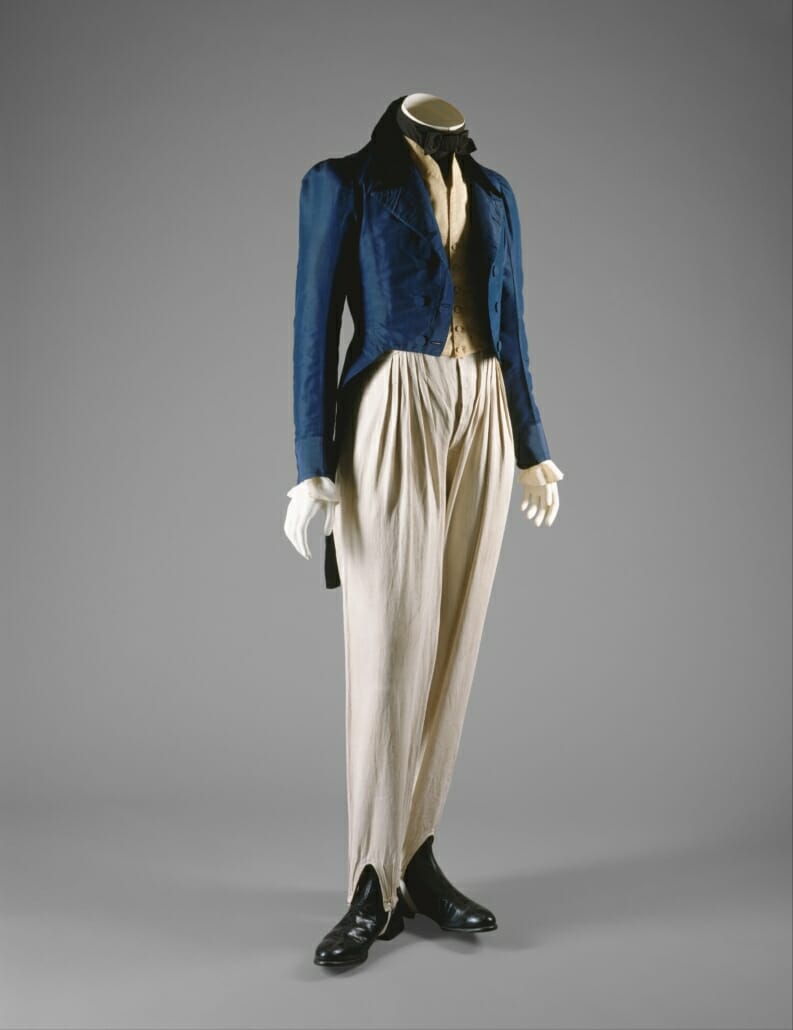
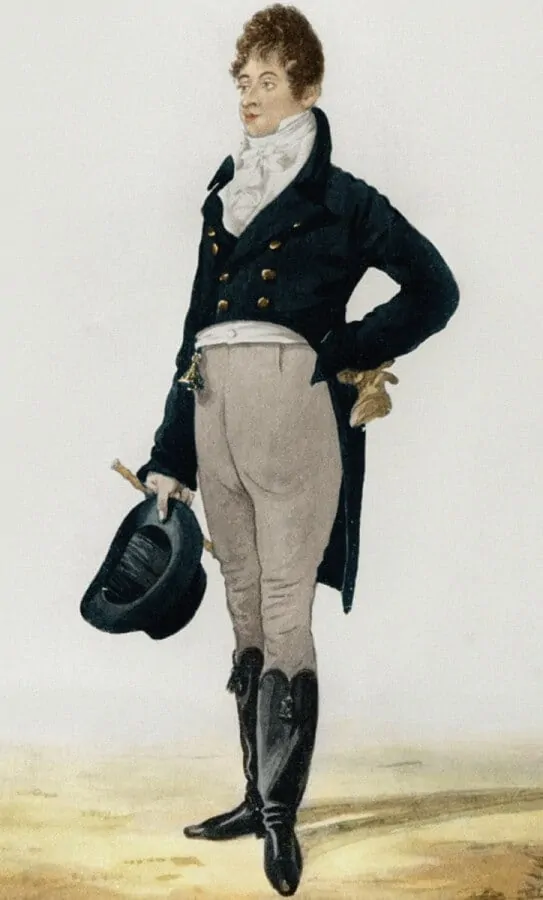
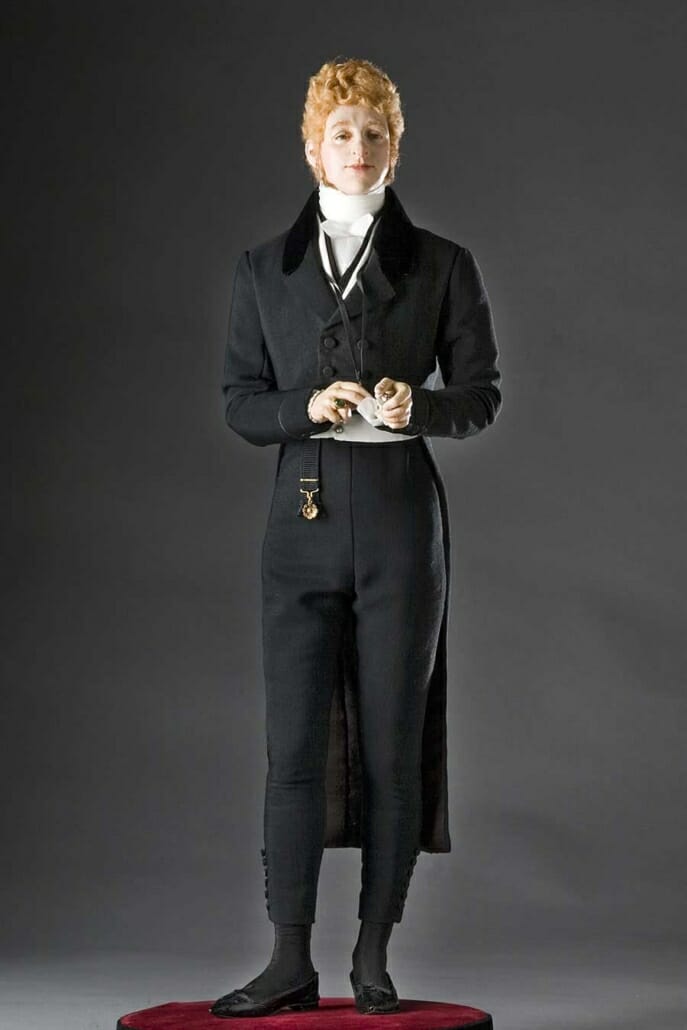
The 20th Century: Tides Turn
By the 1930s, Edward the Prince of Wales had relaxed some menswear rules, leading to softer materials and bolder colors. He also was a supporter of brown slip-on spectator shoes (the most common type of two-toned shoes) and brown shoes in general. By the 1950s, even English clothing guides such as Clothes and the Man by Sydney D. Barney advised:
“Business and Daywear in town: a lounge jacket with matching waistcoat and trousers with footwear in black or brown, according to the suit…Brown shoes with a dark blue suit are undesirable.”
Sydney D. Barney
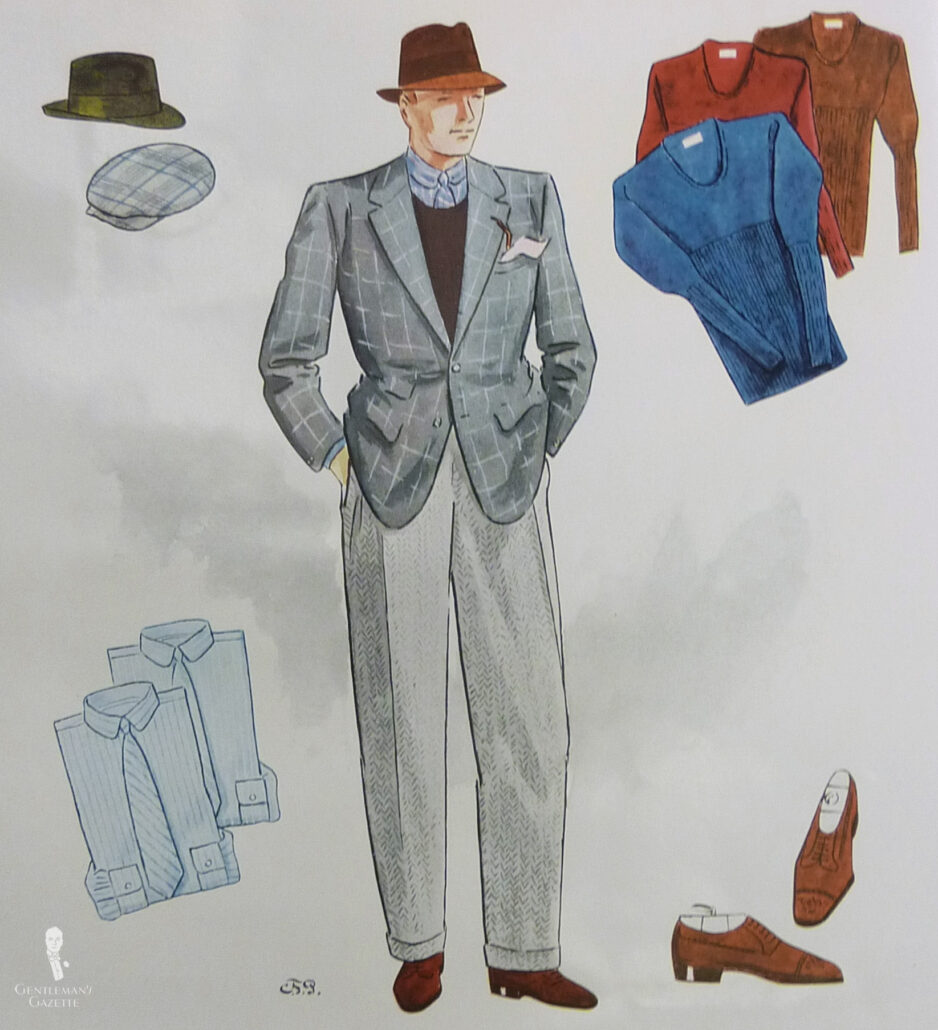
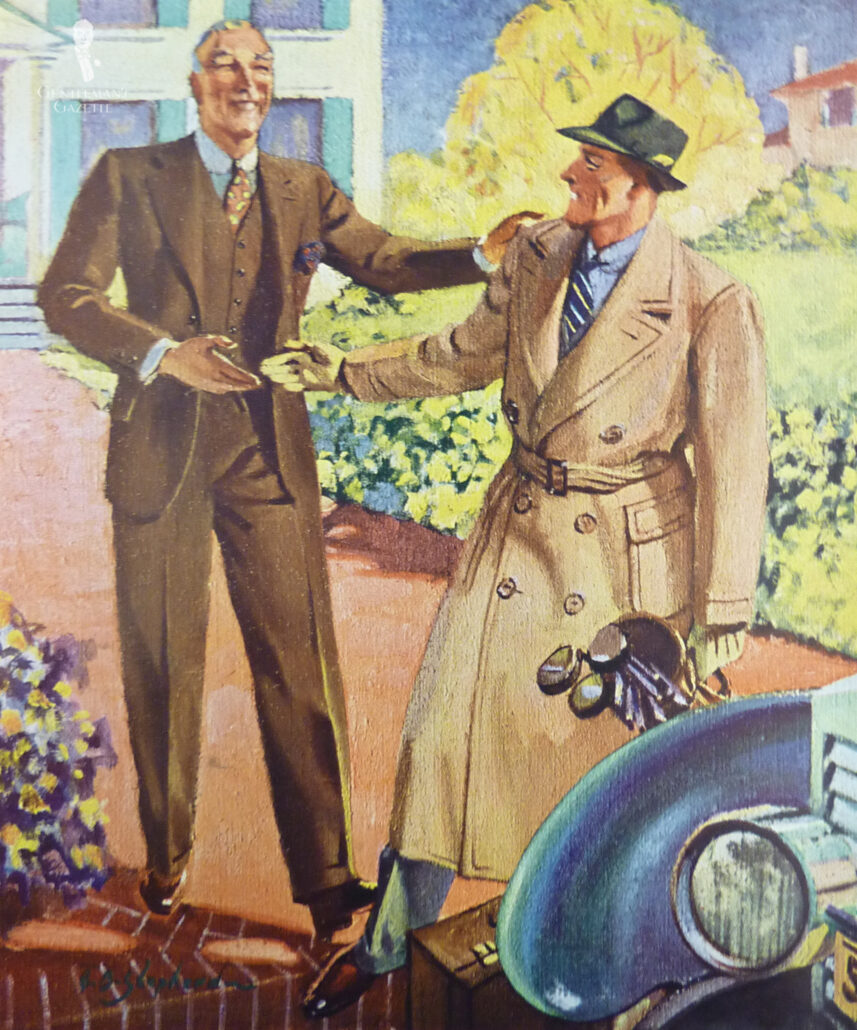
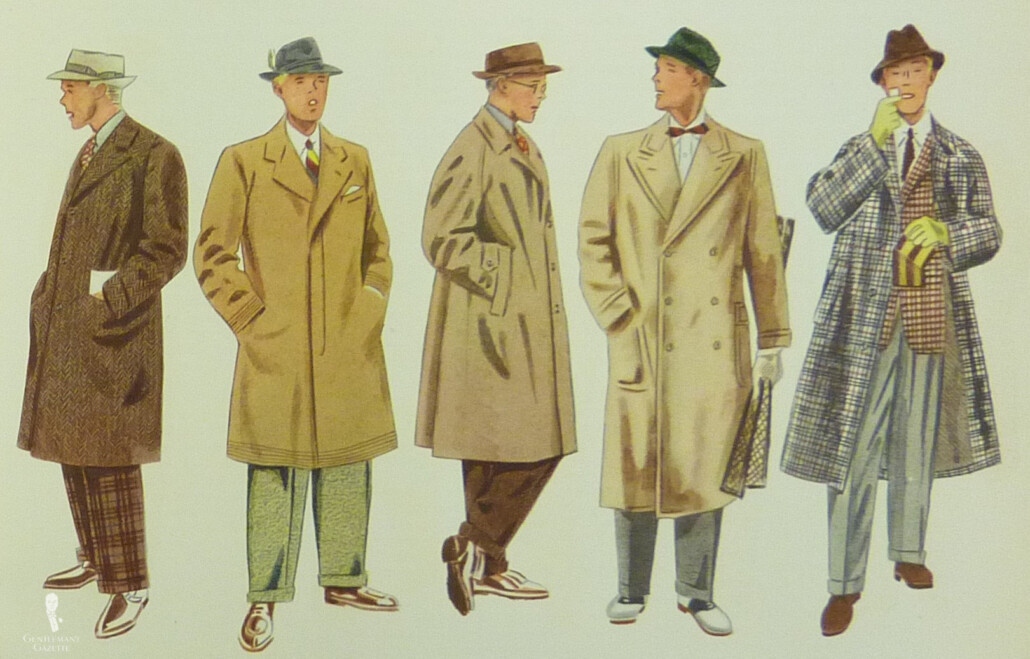
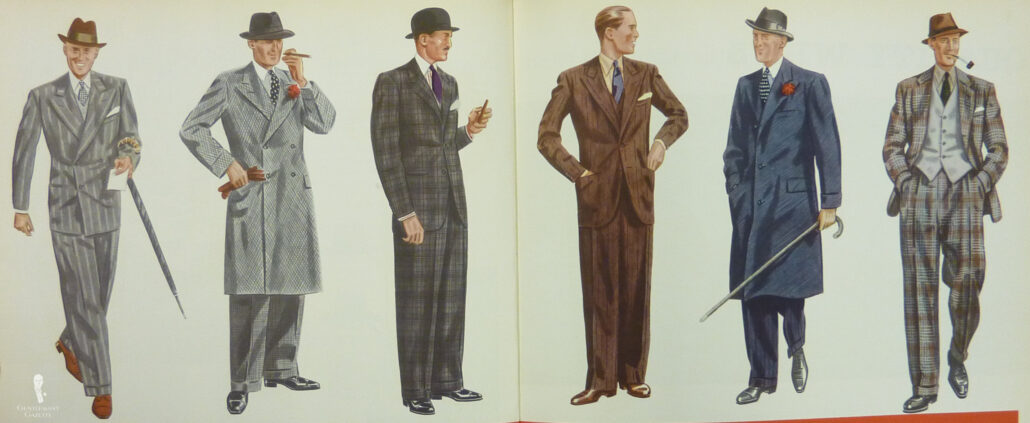
On the other hand, evening dress was still rather formalized; Full Evening Dress with white tie and Dinner Dress both demanded black shoes. These traditional dress codes are much the same today, as you can discover in our in-depth guides. So, you can see, by the 1950s, the “no brown in town” rule was no longer valid, although black was still the color for many business and evening settings.
Modern-Day Views on Brown Boots & Shoes
Today, dress codes are much more relaxed than they were in the fifties, and if you’re wearing a well-cut suit, you are likely to be more well-dressed than 90% of the people around you. Even if you wear more casual brown boots to a restaurant for dinner, chances are that your shoes are still more elegant than many other diners – just make sure you pay attention to said restaurant’s dress code.
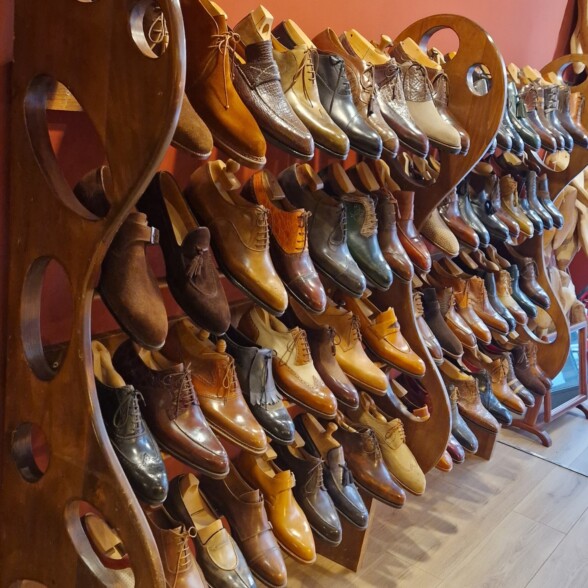
Italy vs. England
Many debonair Italians only wear black dress shoes for funerals, weddings, and formal evening events. Otherwise, they prefer wearing brown leather shoes in varying shades – such as dark brown or tan shoes – especially when paired with blue suits. In Britain, black still holds a certain association with business, at least in more conservative circles. Still, many Englishmen wear more than just black dress shoes for business, with conservative styles like brown Oxford shoes becoming increasingly popular.
To be explicitly clear: Today, wearing brown shoes with your outfits is generally accepted both in town and during the evening. With that said, certain outfits and situations still call for certain footwear; light tan shoes may not be the best option for the evening, and black shoes are imperative for black tie. Remember: just because you can wear brown shoes day and night, doesn’t necessarily mean you should.
Brown Shoes & Boots FAQs
Is it ok to wear brown shoes with black pants?
Brown shoes and black pants should be approached with caution, as it largely depends on the shade of brown shoes and the fabric of the black pants. An unusual combination that works would be black corduroy and tan brown shoes or boots, but black pants with brown shoes should typically be avoided as a combination.
What do men wear with brown shoes?
Brown shoes open up a whole realm of possibilities when it comes to creating unique and interesting outfits. As brown shoes pair more easily with more colors than black ones do, you have access to standard colors like greys, browns, and navy blues, as well as unusual colors like greens, reds, browns, khaki, and purples.
Do brown shoes go with all pants?
Brown shoes will go with almost all pants, but it’s worth mentioning that it will largely depend on the style of shoes and pants. For example, a sleek, elegant brown Oxford shoe pairs very well with more formal trouser options, but won’t pair as well with denim jeans. If that’s the style of pants you want to wear, then opt for more casual brown shoes like loafers or suede chukka boots.
Do brown shoes go with everything?
Brown shoes are certainly more versatile than black shoes and will go with a huge range of options in your wardrobe. Be careful though, as not all combinations are foolproof. For example, avoid pairing brown shoes with black ensembles, such as black business suits, formal morning and evening wear. In these outfits, black shoes are the best choice.
Is it ok to wear a black shirt with brown shoes?
A black shirt with brown shoes may be a viable option, as long as you make the right choice regarding your pants. If it’s a look you want to pull off, take some inspiration from The Talented Mr. Ripley by wearing white or off-white trousers with a black shirt and tan brown shoes. Ensure your clothes fit well with a relaxed cut to ensure the overall casual nature of this outfit comes across correctly.
When can you not wear brown shoes?
Brown shoes are best avoided when you need to obtain a higher level of formality. White-collar environments such as board meetings will likely require black shoes, as well as formal dress codes like morning wear and evening attire including black tie and white tie events.
What are the rules for brown shoes?
While you’ve probably heard the phrase “no brown in town” or “no brown after six”, these rules have been outdated since the 1950s. Nowadays, you have far more agency to wear brown shoes in a wider range of settings and scenarios. If in doubt, use black shoes as a fail-safe option.
When Should You Wear Brown Shoes?
Brown shoes can be worn with almost anything, ranging from blue jeans to cavalry twill and corduroy to flannel, worsteds, and tweed. Unlike black, brown leather comes in an endless variety of shades, allowing you to create a distinguished shoe collection that is unique. Here are a few guidelines that you can adopt and adapt to your own sense of style.
Brown Shoes and Business Suits
For 3-piece or 2-piece business suits, in the following colors, in solid worsteds or flannels, pinstripes or faint windowpanes, or Prince of Wales Checks:
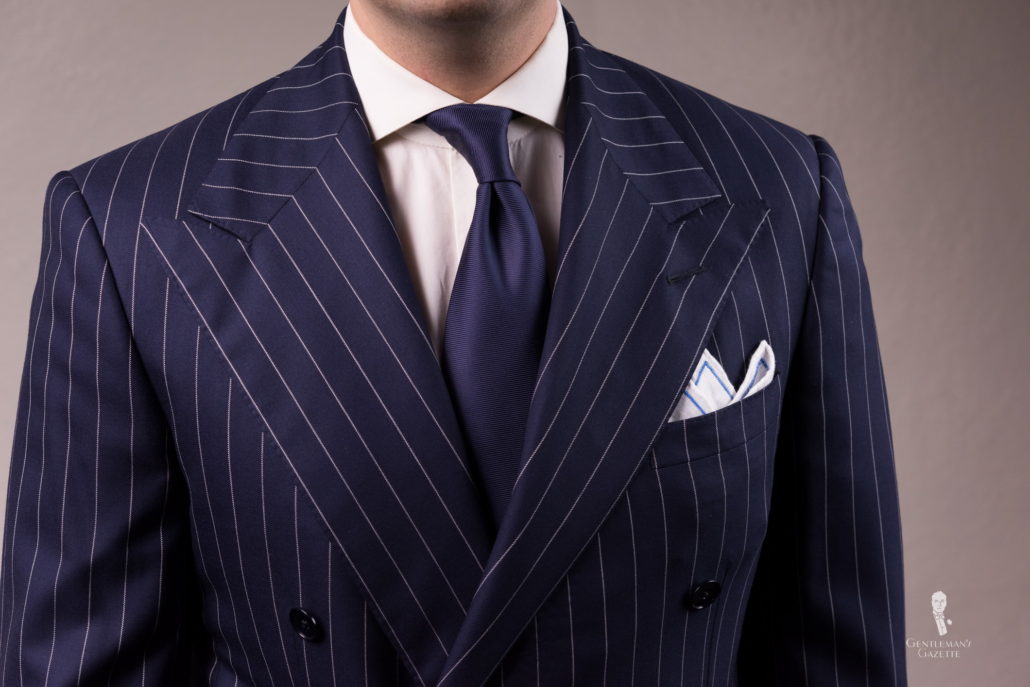
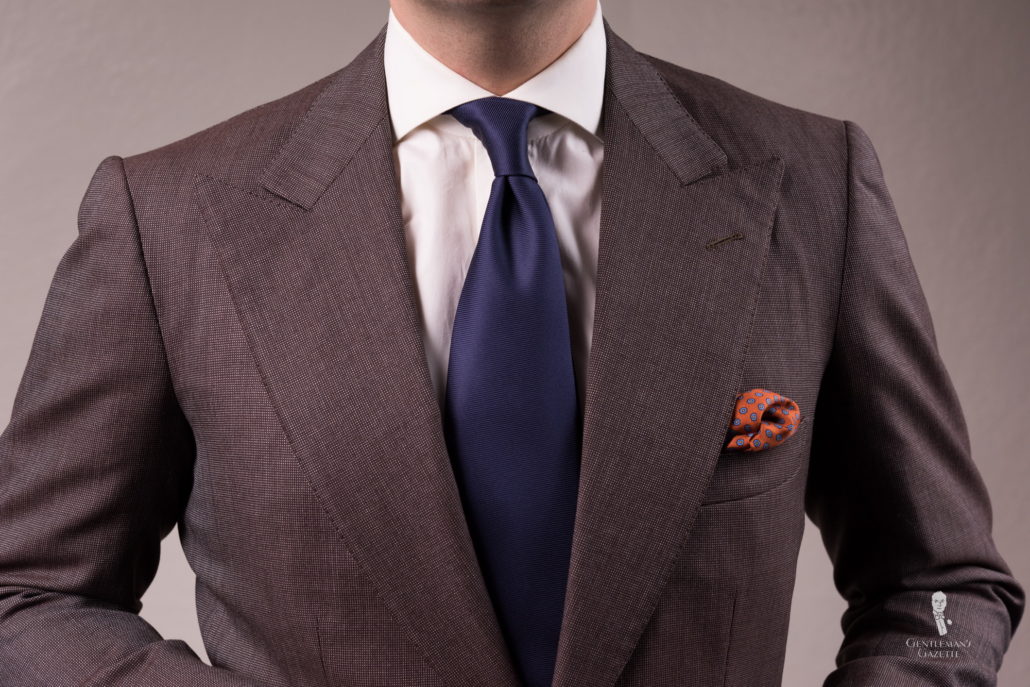
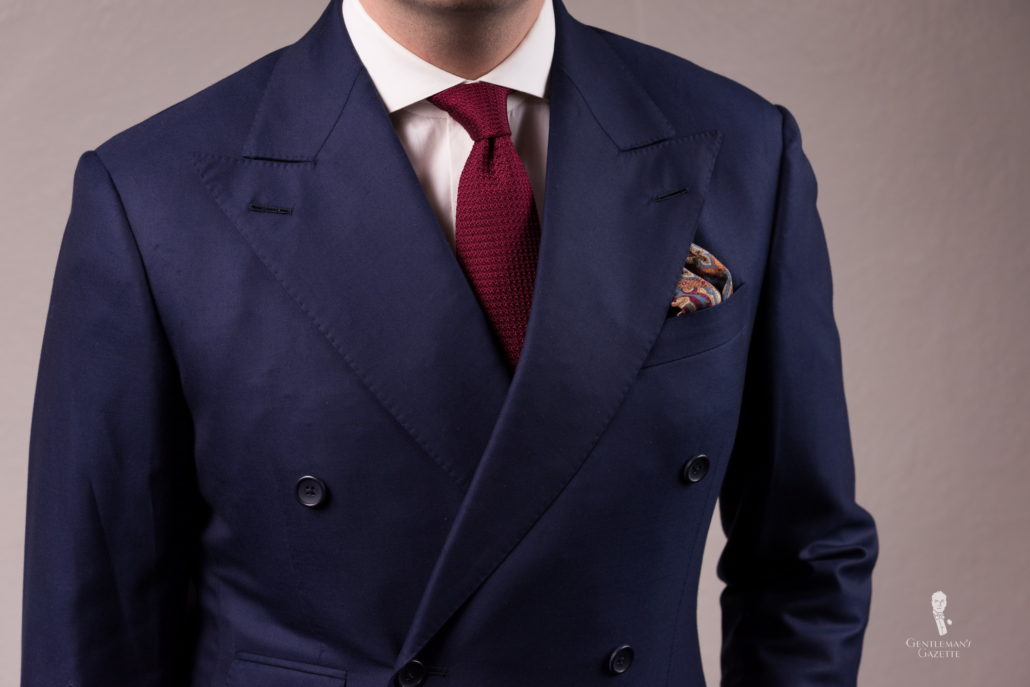
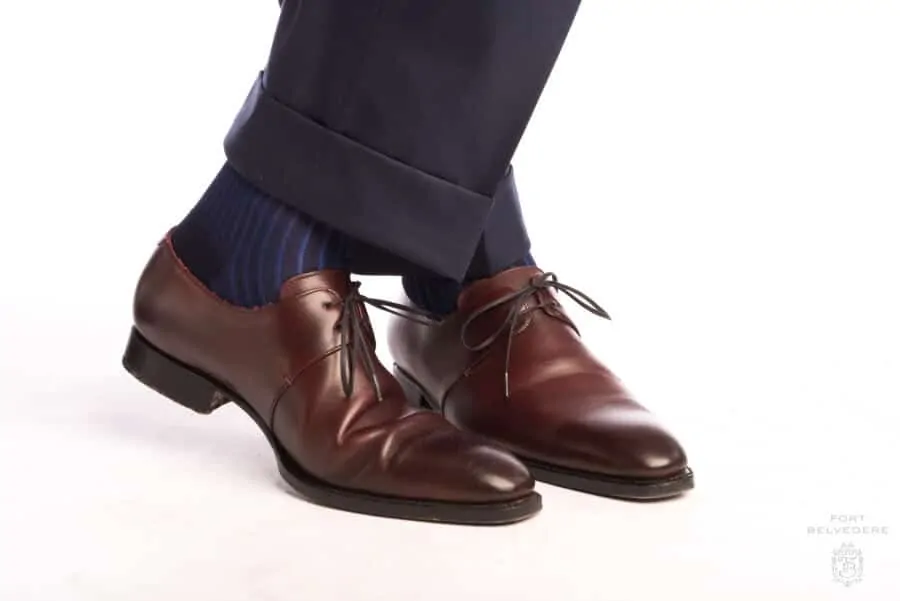
- Charcoal Grey Suits: Dark brown works best here, as a nice alternative to black. Pick browns with reddish or burgundy undertones, and avoid lighter browns such as tan shoes.
- Mid and Light Grey Suits: Dark to mid-brown shoes including brighter cherry tones are excellent choices. Once again, avoid tan when wearing darker greys, but feel free to include tan brown shoes with lighter grey suits.
- Dark Navy Suits: Black works well with a navy suit, but cordovan, tan, and dark brown shoes and boots also look magnificent and dashing. Of course, you will stand out visually with light tan shoes and a navy suit – something to bear in mind if you prefer a more subtle aesthetic.
- Lighter Blue Suits: Depending on the shade of blue, you have a whole spectrum of colors to choose from, so you’ll have to look at other features within your lighter blue suits to make the right decision. If your suit is on the casual side, then go for lighter brown tones, while darker brown footwear will pair better with more formal details.
- Dark Brown Suits: Pair a dark brown suit with brown shoes, and skip black altogether. Keep your brown shoes to a complimentary tone, sticking with darker browns where possible.
- Black Suits: Simply put, don’t wear a black suit with brown shoes. Black shoes, in a conservative style, work best.
Brown Shoes and Casual Suits
Casual suits can feature the colors previously listed, but they’ll include bolder patterns, details, or material blends such as brushed cotton, corduroy, and the like. You’ll also find casual suits come in a wider range of colors, too:
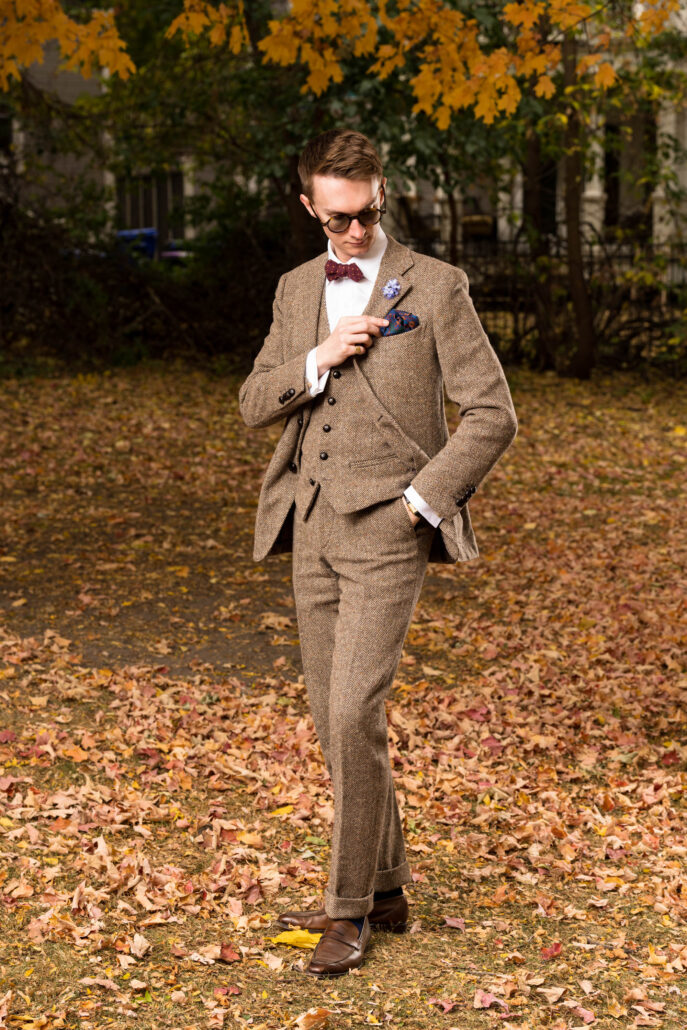
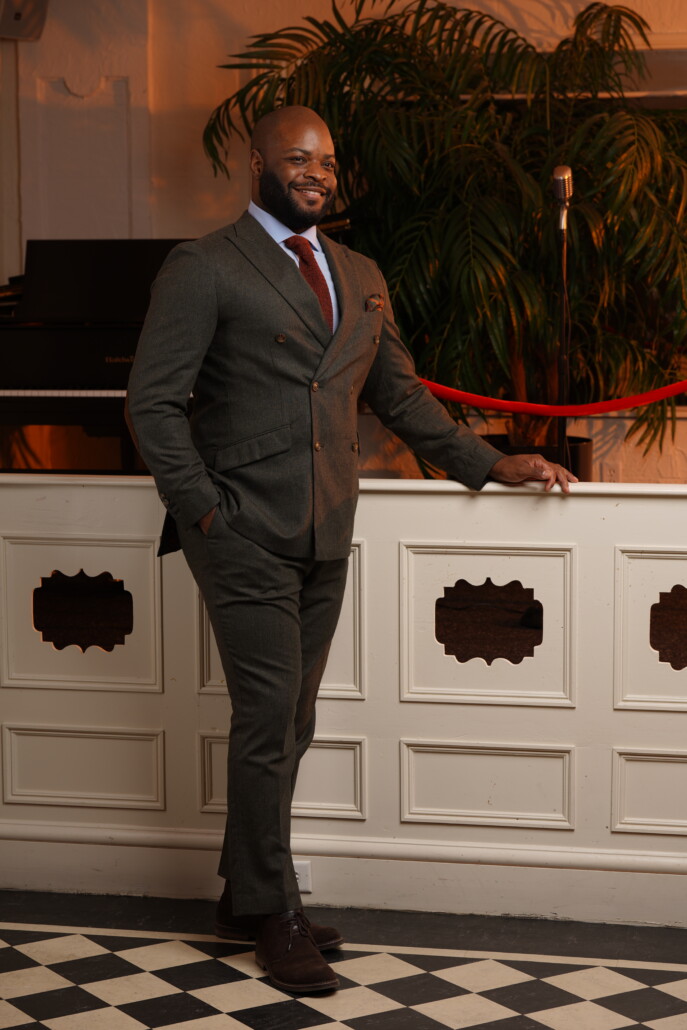
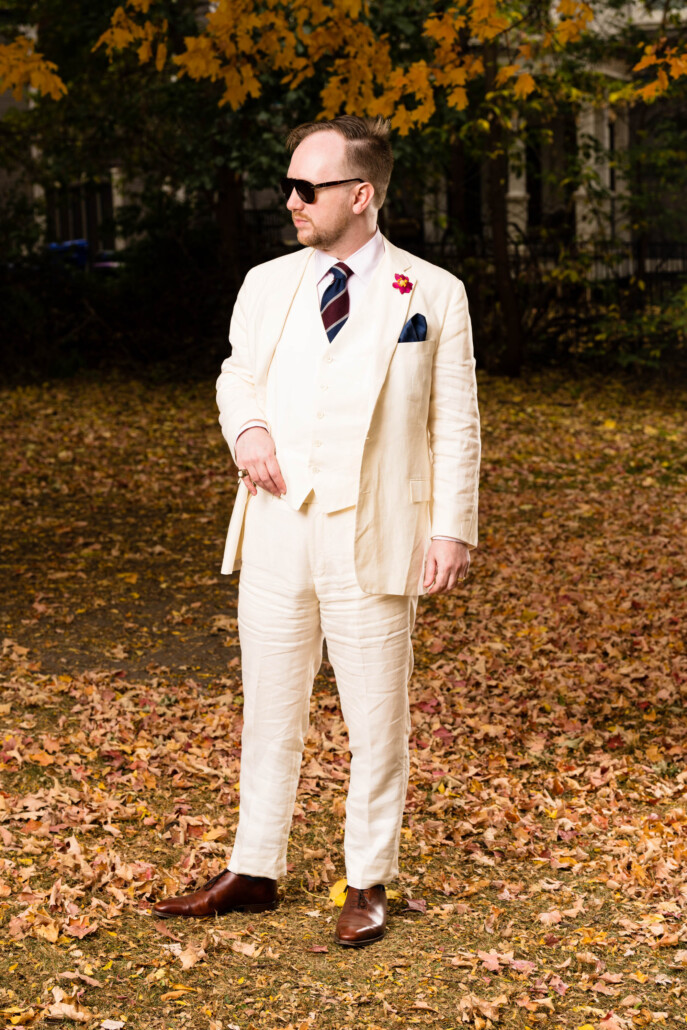
- Green Suits: Simply put, brown shoes and boots work best here every time, for all shades. Avoid black shoes, which create too much contrast and are visually jarring.
- Khaki Suits: Dark browns work well here, as do lighter tones of brown such as tan. Avoid black shoes again, for the same reasons as above.
- Tan Suits: Cordovan, cherry, and medium brown footwear choices are great. The reddish tones will play to the strengths of the warm nature of tan suits.
- White & Off-White Suits: Two-toned shoes, such as brown-and-white spectators, are a dapper choice, but dark brown, mid-brown, or reddish brown work well.
How to Pair Brown Shoes & Boots: Expert Tips
For a fail-safe approach, always choose a shade of brown dress shoes darker than your suit color.
If you are confident enough, you can pair lighter brown shoes with darker suits, but be aware that you will gather more attention that way.
Since a 3-piece suit is more formal than a 2-piece suit, the heightened formality of black shoes means they will generally pair better with such outfits. Still, brown shoes and boots can work when they are dark enough in tone.
If you wear a contrasting double-breasted waistcoat in dove grey or buff, consider that black shoes might be best as you will have created a similar ensemble to the formal stroller suit.
Don’t forget that black remains the number one color for business, so if you’re unsure, stick with black. When you invest in your first pair of business shoes, go with a black cap toe Oxford shoe, and choose a brown shoe for your second investment.
Brown Shoes and Sports Coats
As business casual dress codes continue to evolve, pairing an odd jacket with separate trousers creates interesting combinations. Materials may include Fresco, Tweed, Thornproof, Cheviot, Donegal, Flannel, Worsted, Corduroy, Velvet, Cotton, Linen, and Gabardine:
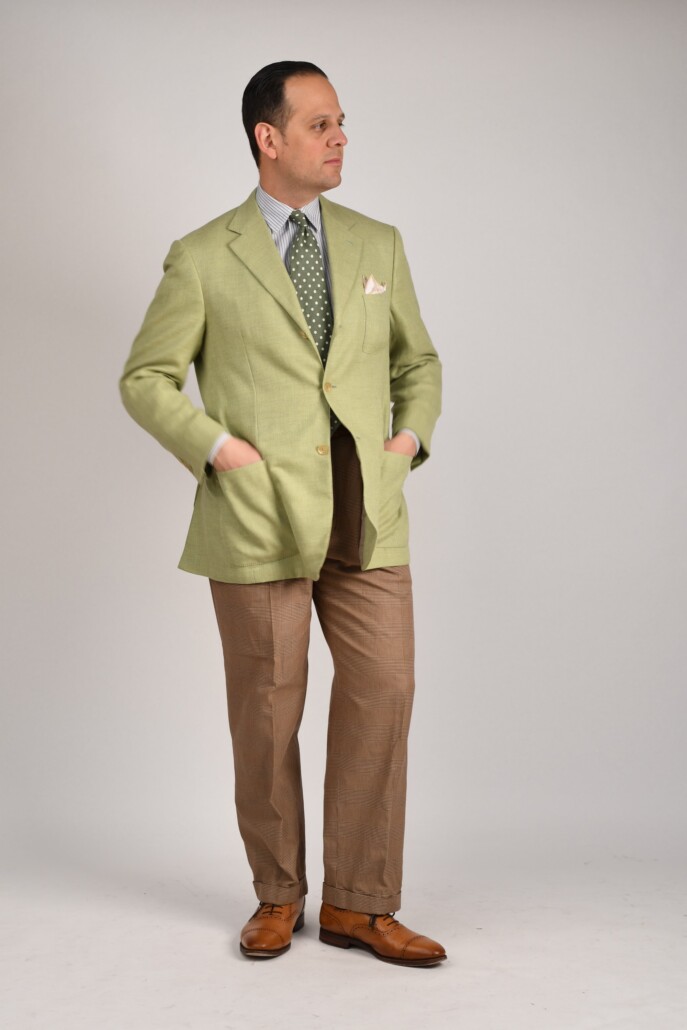
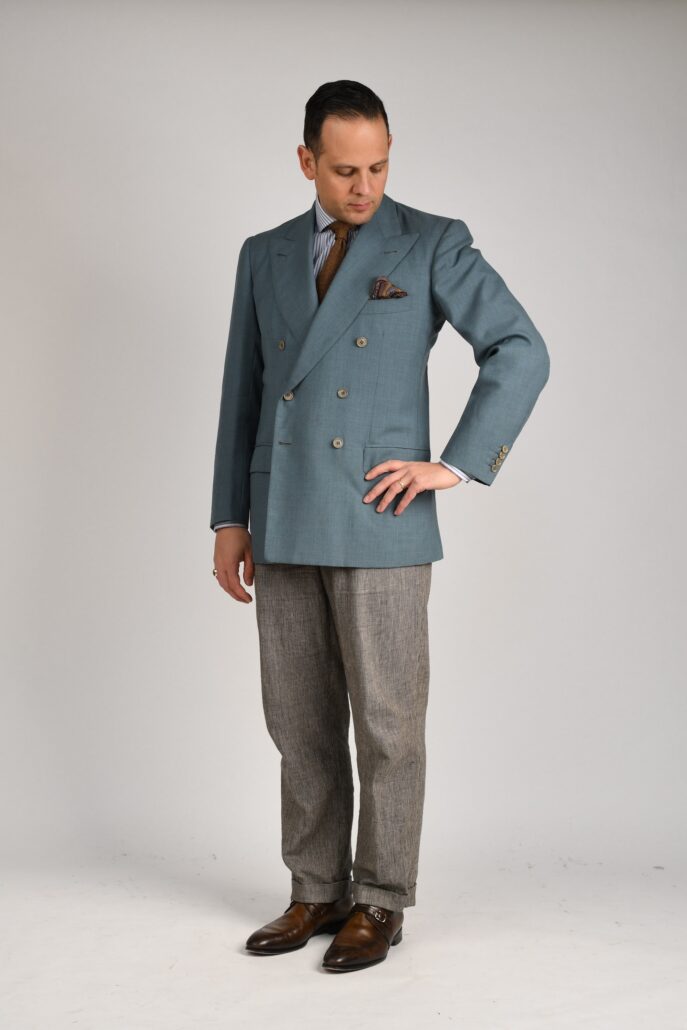
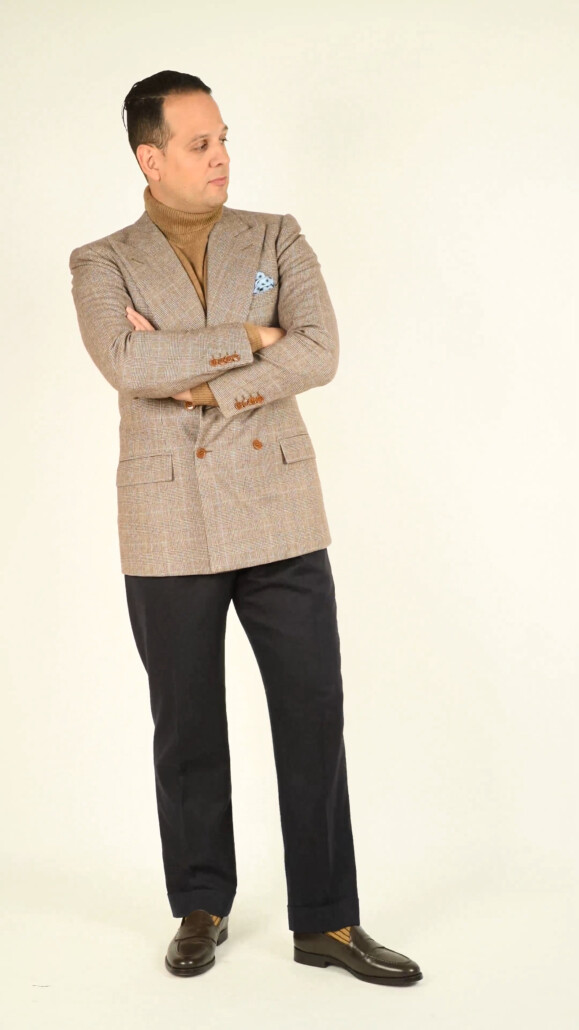
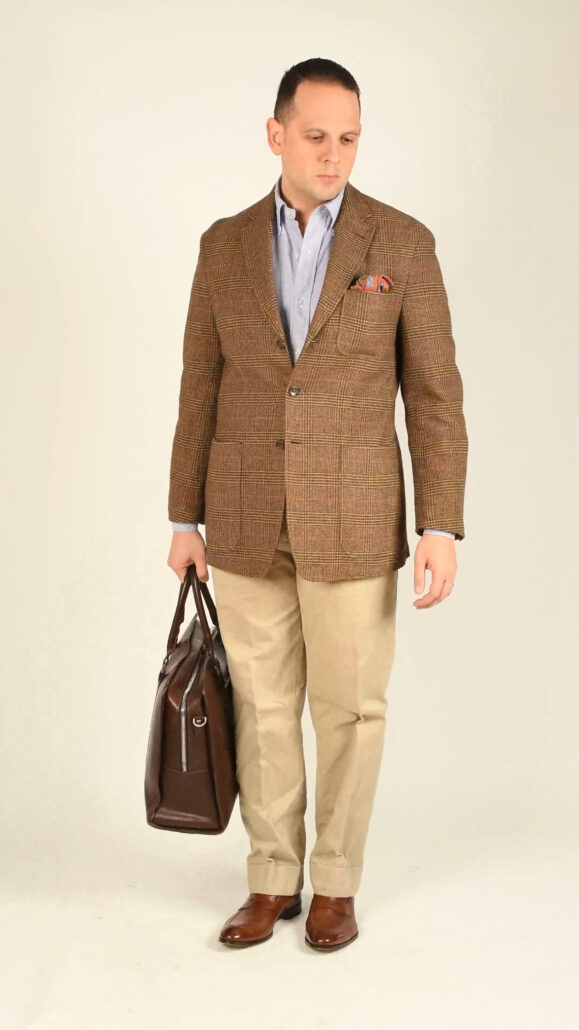
- Charcoal Grey Separates: We suggest black over any form of brown. Dark brown can work, but avoid tan.
- Separates in Mid-Grey: Black works, but dark brown and cherry are also good colors. Avoid tan shoes.
- Odd Blue Garments: All kinds of brown men’s dress shoes can be worn with blue colors – cordovan, tan and dark brown can look especially smart. As before, you will garner more attention with a light tan shoe.
- Denim Jeans & Jackets: Basically, all kinds of brown leather shoes work well, even with black jeans (similar to the corduroy example above). Tan and cordovan oxblood will serve you well here. Leather boots are a natural pair for jeans, though anything with a higher ankle would naturally interfere with skinny jeans (not that we necessarily advocate for such a style)!
- Garments in Red: All shades of brown work well, though reddish brown can look a bit too deliberate. Dark brown and tan are good choices
- Green Tones: As before, try wearing brown every time, for all shades. Avoid black.
- Dark Brown: In a more smart-casual outfit such as this, tan works well when paired with dark brown.
- Black: With black corduroy, tan leather boots (such as chukka boots or desert boots) are a good choice. Black dress pants worn with a sport coat will look best with black shoes, though more casual shoes like black loafers could be a good compromise in terms of formality.
- Unsure What To Wear? Brown is the best shoe and boot color for sports coats and contrasting trousers. Sometimes you may also see boots or shoes with fabric inserts, which can be quite stylish.
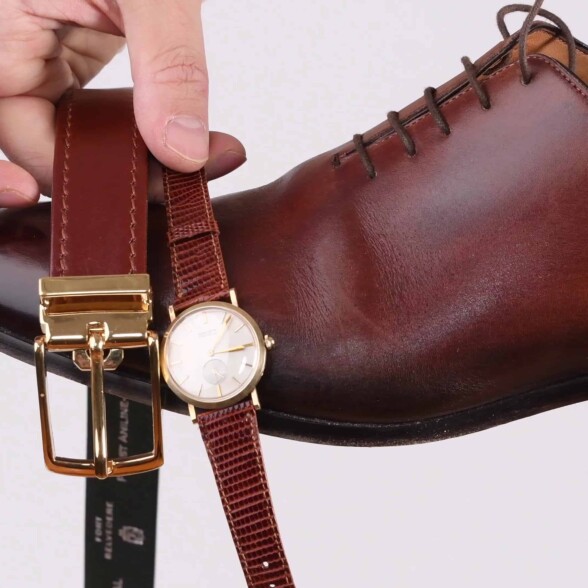
Match Your Leathers
If you’re wearing a belt, try to match the color of the shoe to that of the belt. The same applies for any leather accessories you wear on your person, such as a watch strap. Since there are so many shades of brown leather shoes, your belt and watch strap don’t have to be made of the exact same leather or the same color – just try to match them as closely as possible to create a harmonious look. Larger leather items like bags and briefcases aren’t expected to match your shoe color exactly – that would be quite expensive, otherwise!
When Shouldn’t You Wear Brown Shoes?
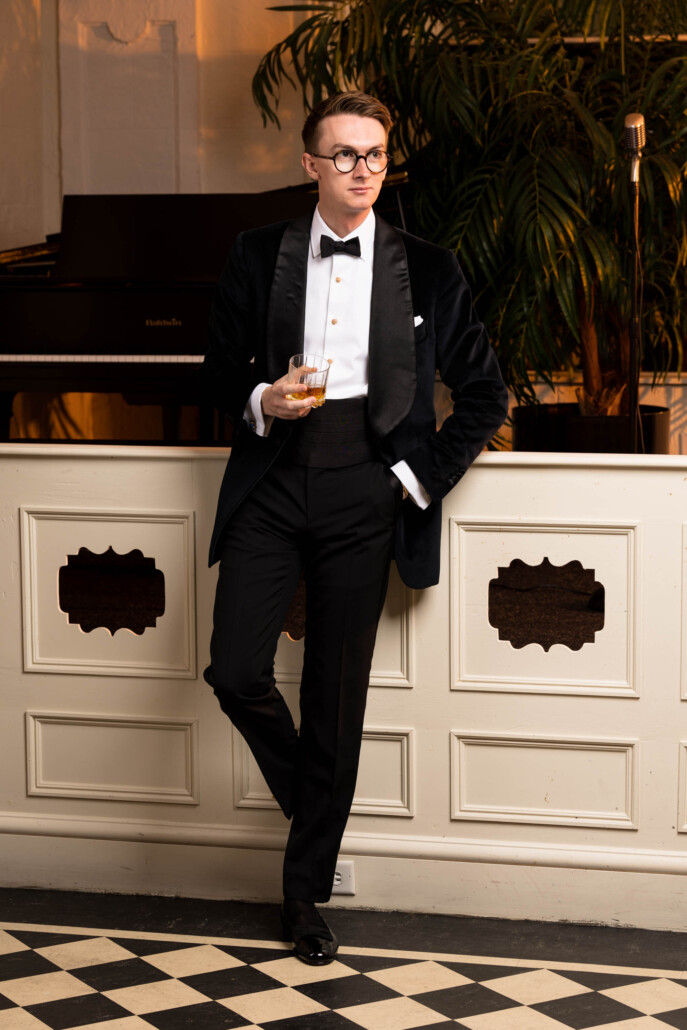
If you wear formal morning dress (morning coat or stroller) or formal evening dress (white tie or black tie) you should not wear brown shoes – go with black. The exception for this exception could be a tuxedo in brown, as worn by Noël Coward, Nick Foulkes, or Lapo Elkann. In that case, a pair of matching velvet slippers could be an option, but that’s only for the very advanced clothes horse.
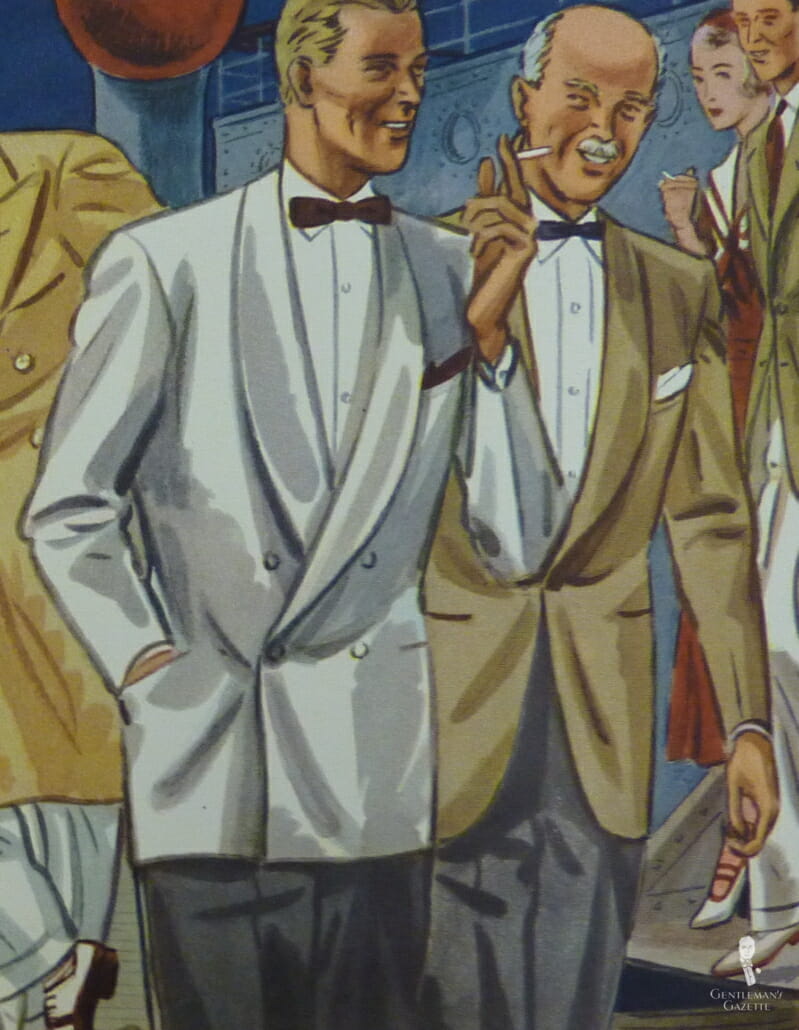
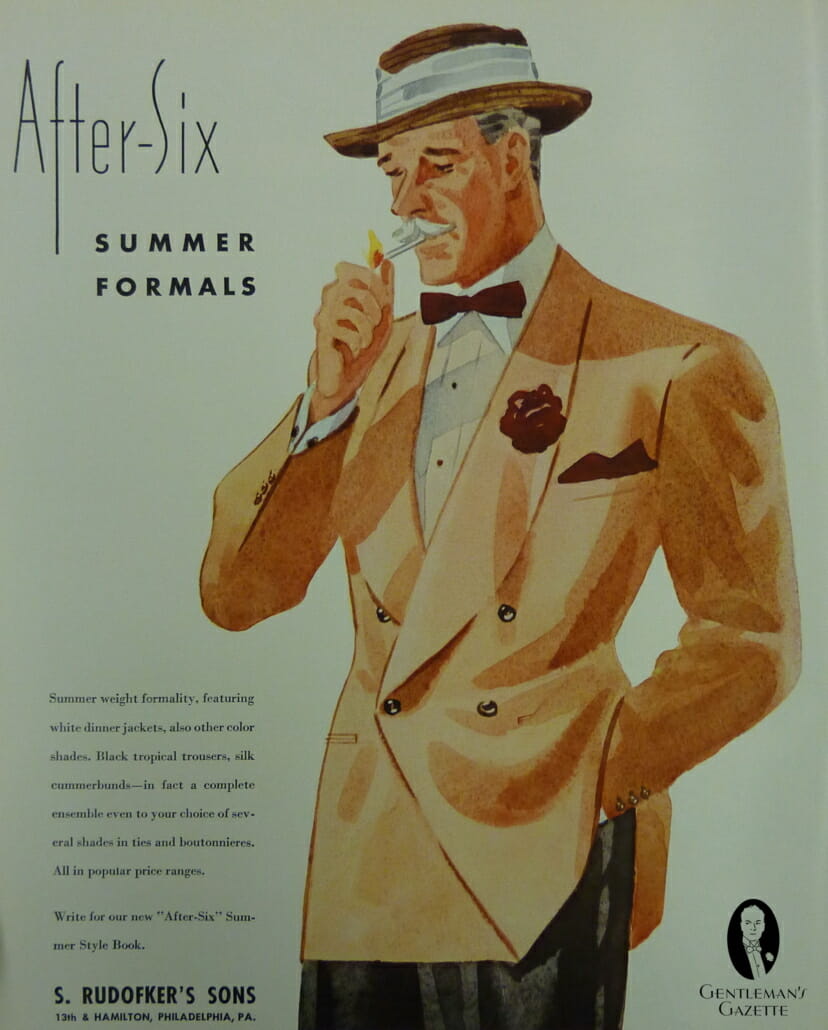
Some traditionalists would argue that you should not wear brown shoes to the opera. However, if you look at the general dress code at operas today, you will likely be more well-dressed in a conservative pair of brown shoes than the other attendees.
Learning From The Past: Combining Brown Shoes, Pants, and Socks
Brown Shoes & Navy Pants
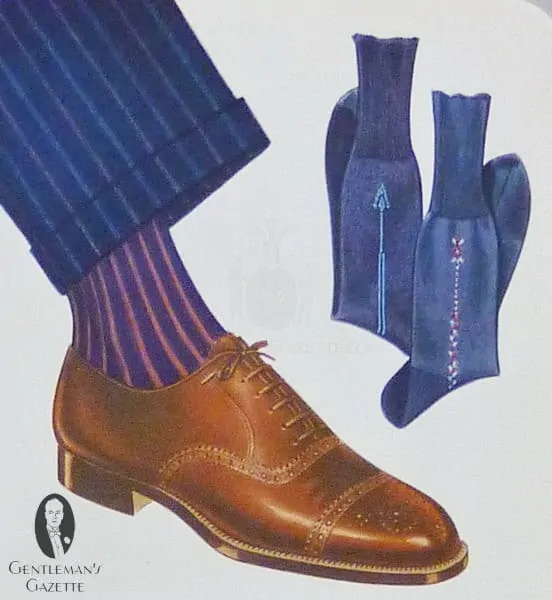
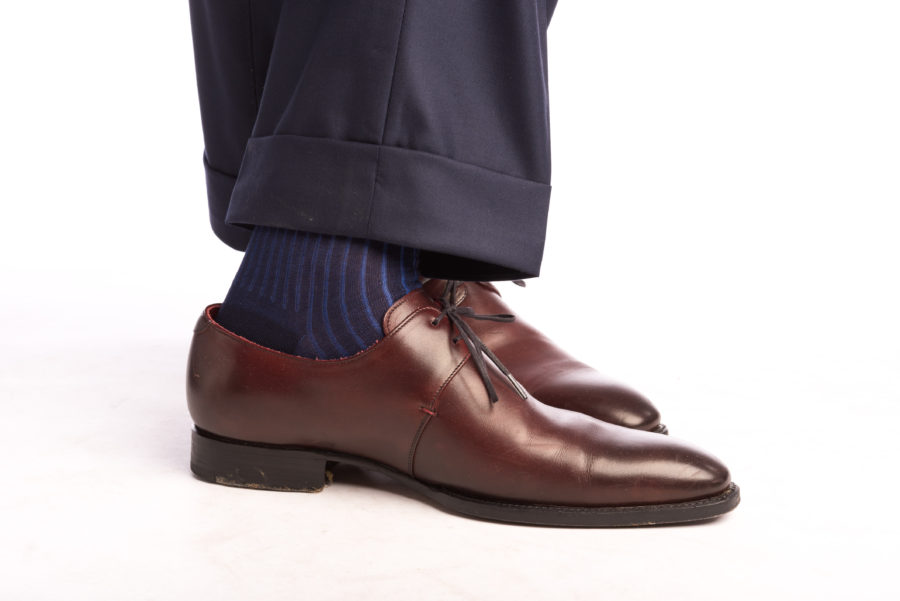
In the vintage illustration above, a navy chalk stripe worsted suit is paired with chestnut brown calf leather brogues. This illustration is from the 1930s, proving that men wore dark suits with brown shoes even then. Moreover, they were experimenting with creative weaves, such as these beautiful shadow stripe socks in blue and red (which can be worn with all kinds of navy suits). Alternatively, blue socks with blue stripes would be a more subtle alternative.
Brown Shoes & Warm Tones
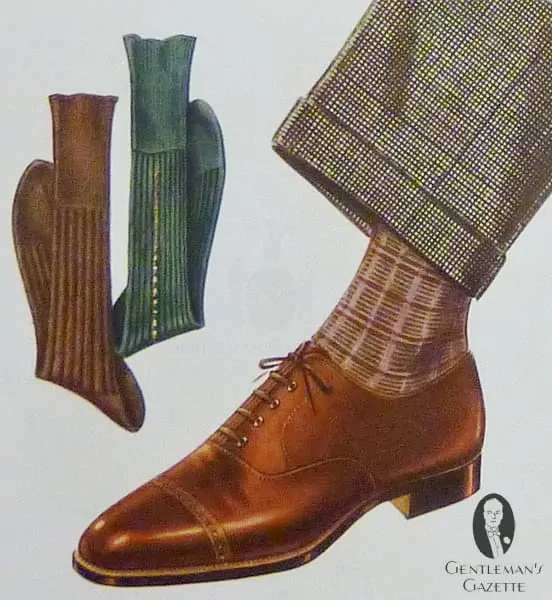
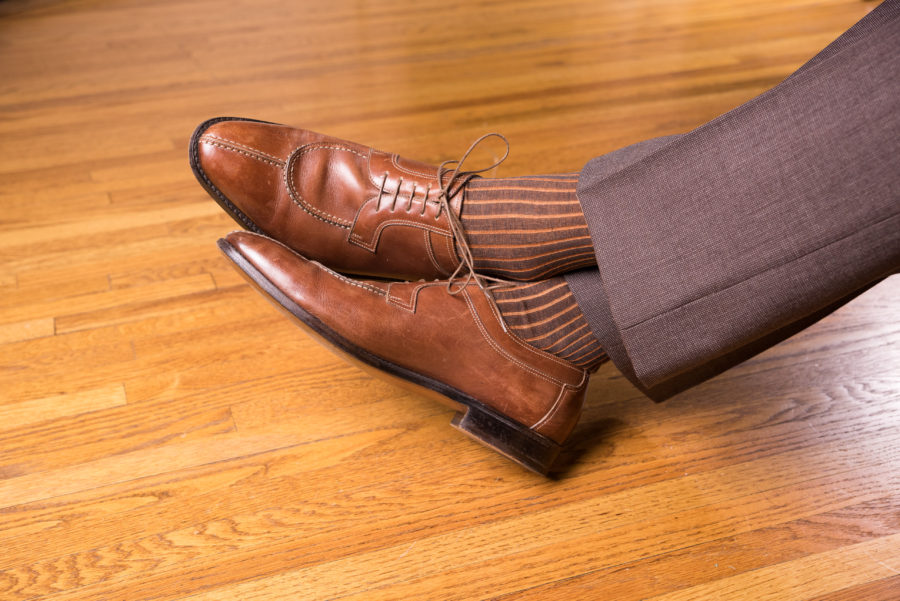
The above illustration shows the benefit of understanding color temperature–that is, pairing shoes, socks, and trousers with a warm tone. We’ve used this as inspiration to pair some mid-brown split-toe derby shoes with brown and orange shadow-striped socks that lean into the warm tones. The mottled grey and brown tones in the trousers harmonize nicely with the combination.
Brown Boots & Bold Socks
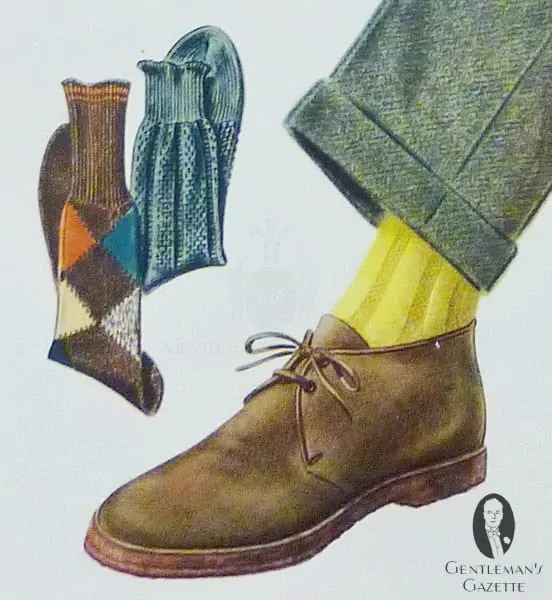
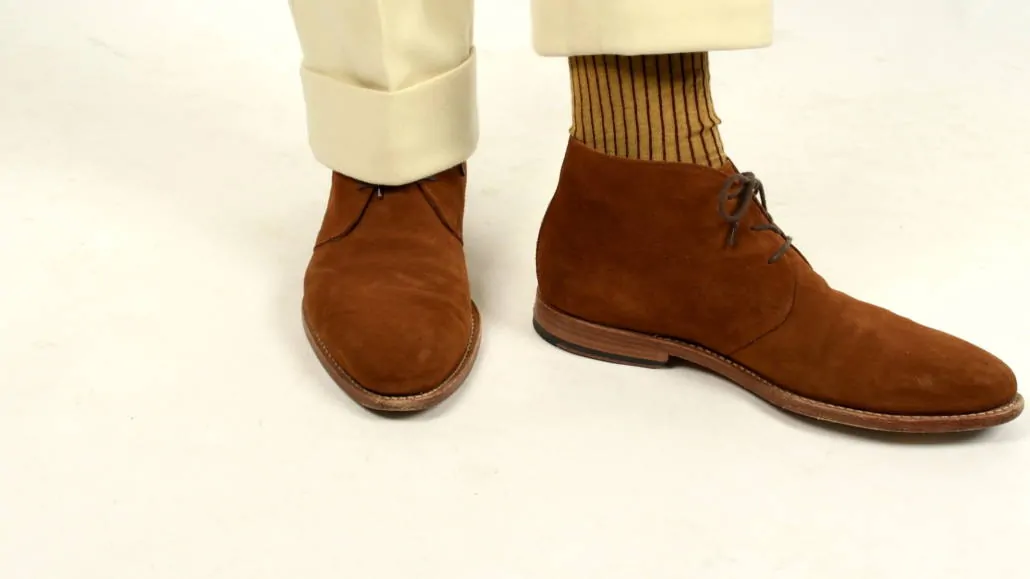
Here, grey-green pants pair well with mid-brown suede chukkas, underscoring the versatility of both this particular boot style and of suede shoes in general. The ensemble is brightened up further with some yellow socks. Bright pastel hosiery can be a smart way to add a pop of color that isn’t always visible; Fred Astaire was a proponent of this technique, often wearing things like pink socks in his outfits for films. We’ve opted to replicate the look with a pair of tobacco suede chukka boots and shadow-striped socks in khaki and navy. The off-white trousers with a strong cuff add a smart element to this otherwise casual look.
Brown Shoes for Casual Looks
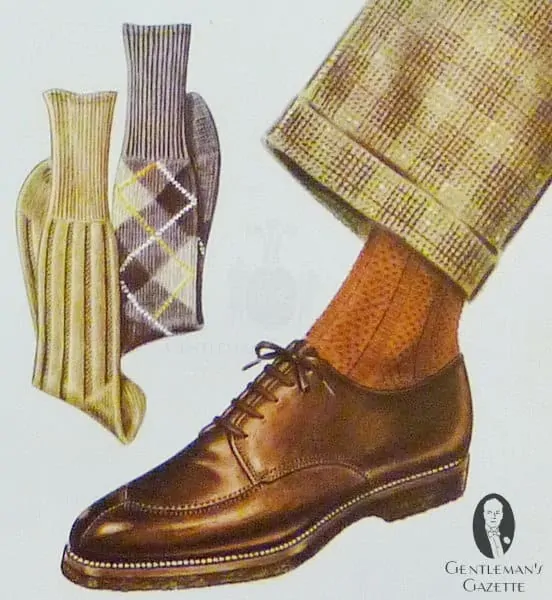
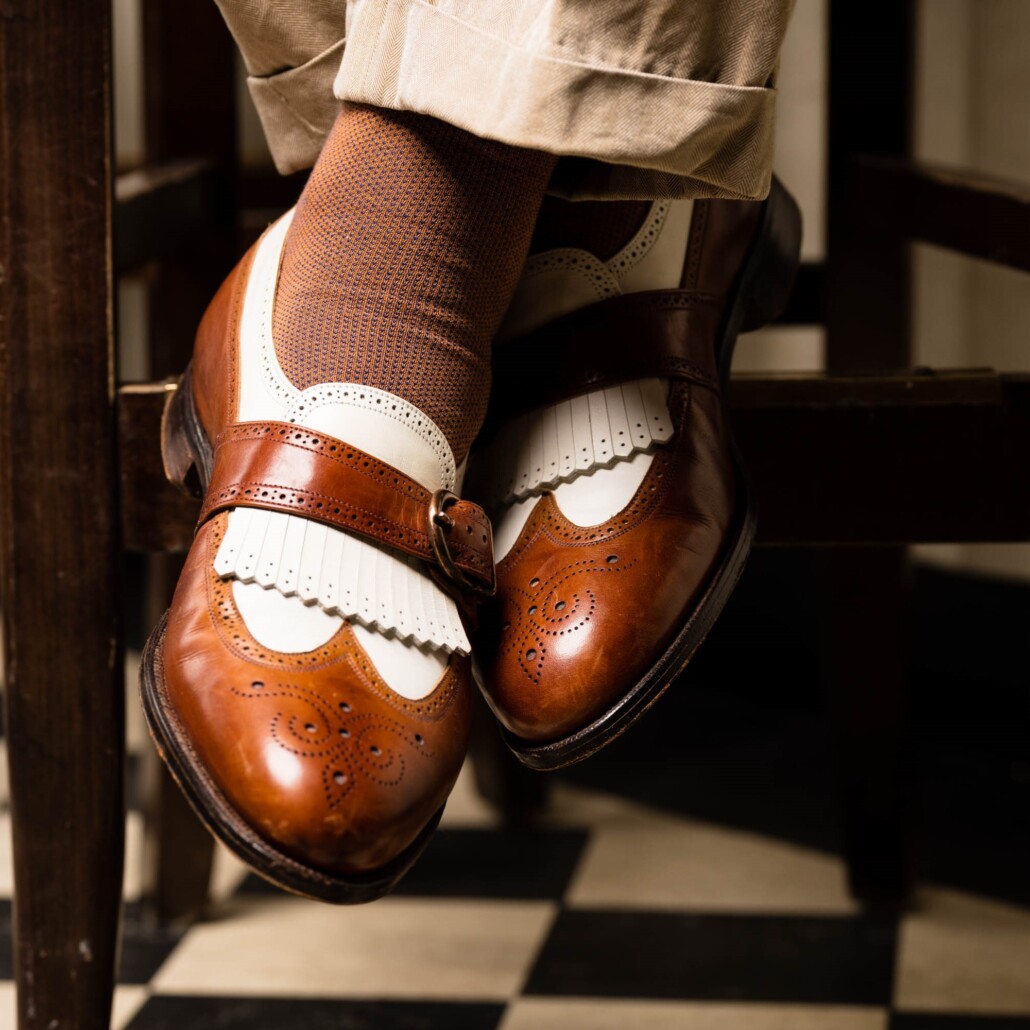
These checked pants are made of Shetland tweed, and they pair well with the rust-orange, over-the-calf socks and chocolate brown Norwegian shoes with crepe soles. This type of sole is more commonly associated with styles like desert boots, though it can work equally well with footwear with a lower ankle, as shown here. Our take on this idea uses a pair of classic cotton chinos with similar orange and navy over-the-calf socks, and a pair of monk-strap loafers in the spectator style featuring brogue detailing that ties everything together.
Tan Brown Suede Shoes for Everyday Wearability
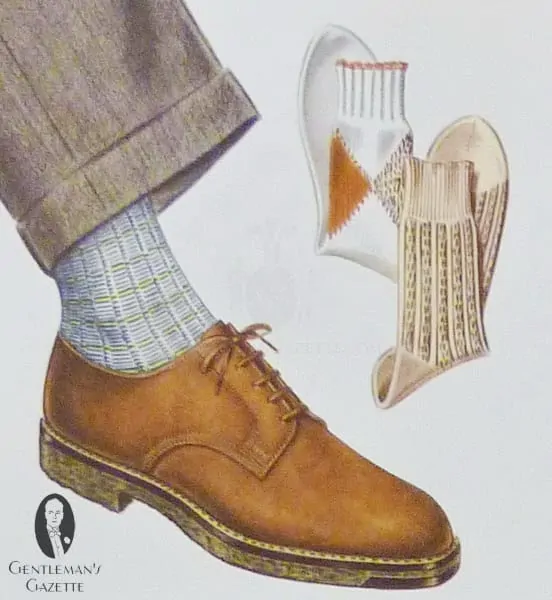
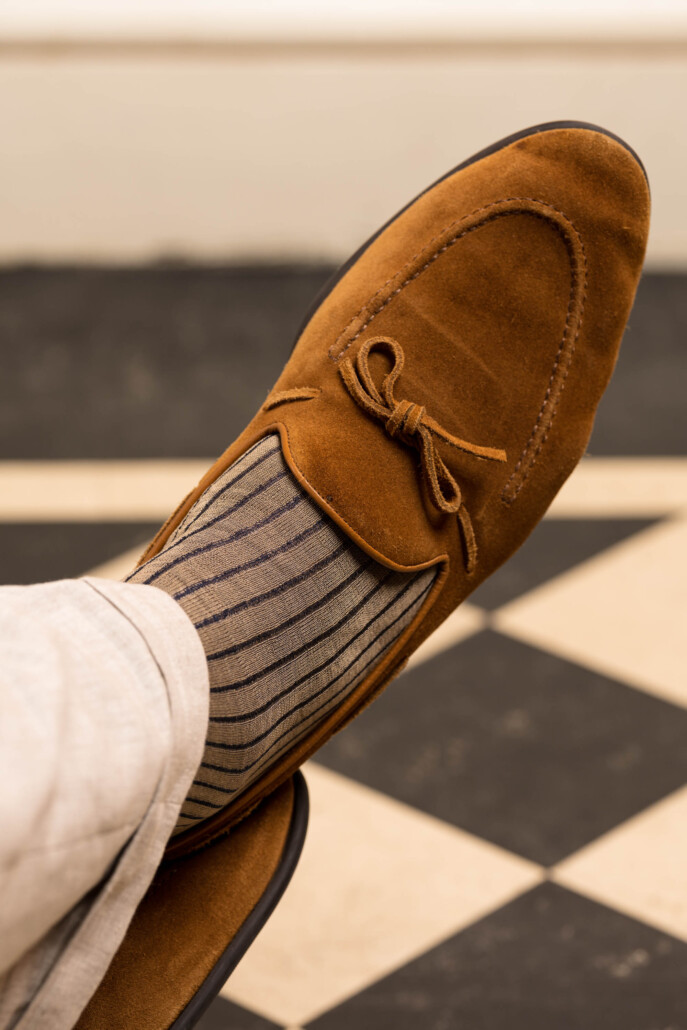
The solid brown blucher or derby is a wardrobe staple because it pairs with almost every kind of informal outfit. The shoe in this illustration, while conservatively styled in terms of its leather upper, has a bit more character in its sole, featuring a solid heel and a layered toe. Keeping tan suede leather as a material, we’re showcasing how a pair of unlined loafers can bring unmatched comfort and style to a similar outfit. Utilizing a similar pattern in socks with an equally light tone, these Fort Belvedere khaki and navy shadow-striped socks offer a bridge between the shoe and the lighter pants.
Brown Monk Straps: A Modern Classic
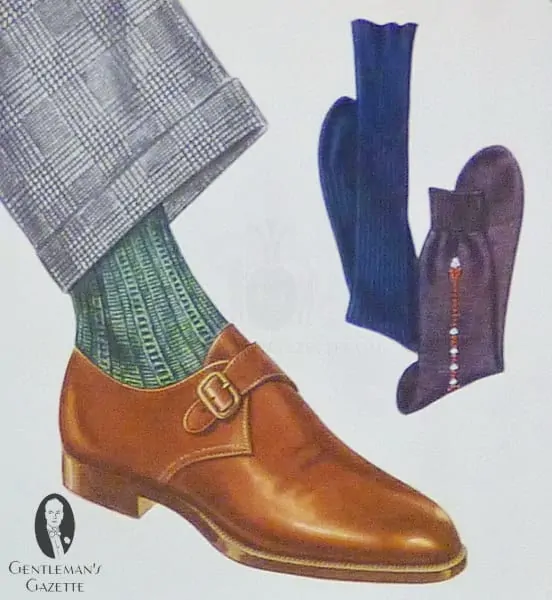
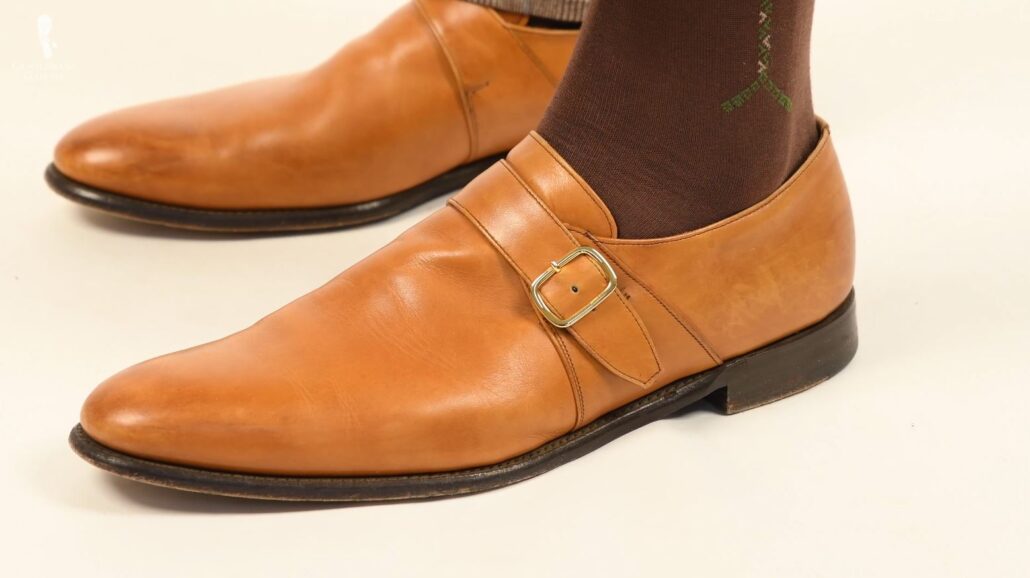
Here, a classic Prince of Wales suit is combined with a mid-brown monk strap shoe and green socks. Blue would work just as well as a sock color, and perhaps even a combination of green & purple. While monk straps have a historical precedent, as shown here, they have exploded in popularity in the 21st century, as their formality level is above that of styles like loafers and boat shoes, but not quite as reserved as Oxfords. We’ve paired an almost identical shoe with brown Prince of Wales check trousers, and a fine pair of brown cotton socks featuring green clocks – a vintage detail rarely seen nowadays.
Brown Shoes & Purple Socks: A Perfect Pairing
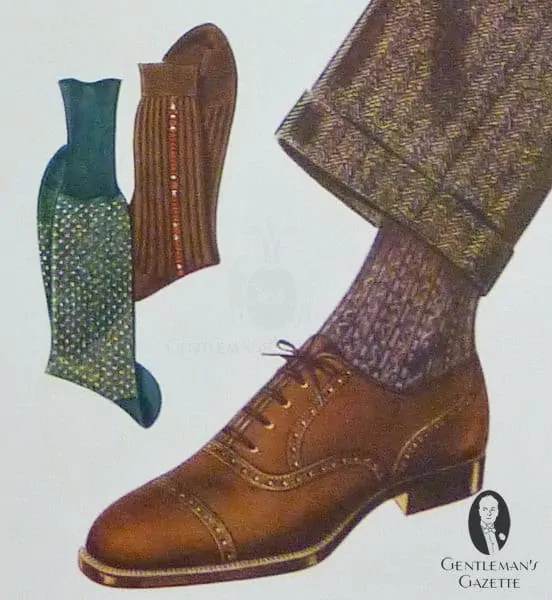
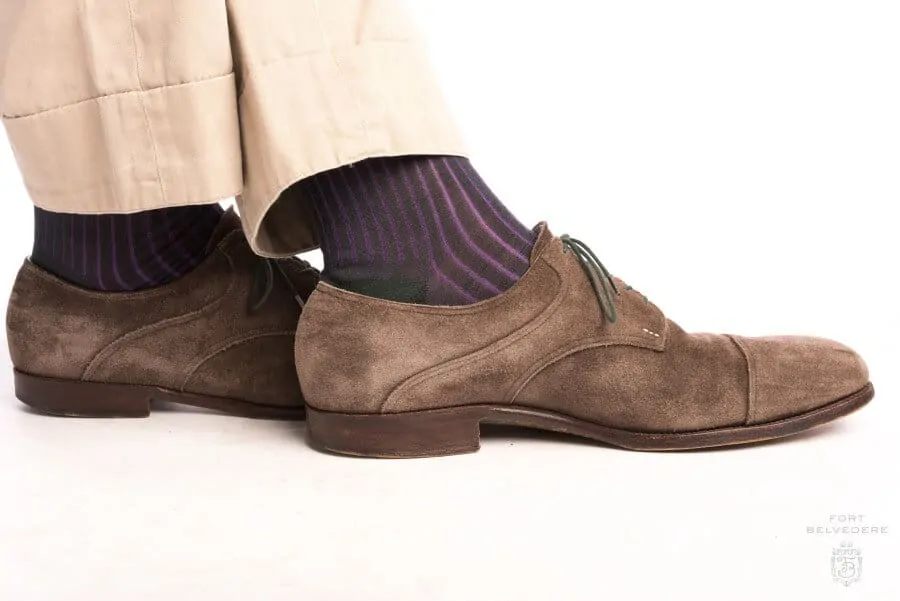
This mid-brown herringbone suit pairs well with a mid-brown brogued shoe and a pair of heather purple socks. There are many styles of brogues, of course, and the more broguing a shoe features, the less formal it is. Inspired by the purple socks, we’ve included a shadow-striped pair in purple and green that perform the same function. Instead of brogues, we’ve opted for a pair of brown suede shoes, which are equally casual.
Change The Look Of Your Brown Shoes With Shoelaces
One of the quickest and most simple ways to change the look and feel of your brown shoes is to simply change your shoelaces. The advantages are simple: it’s quick, easy, inexpensive, and reversible.
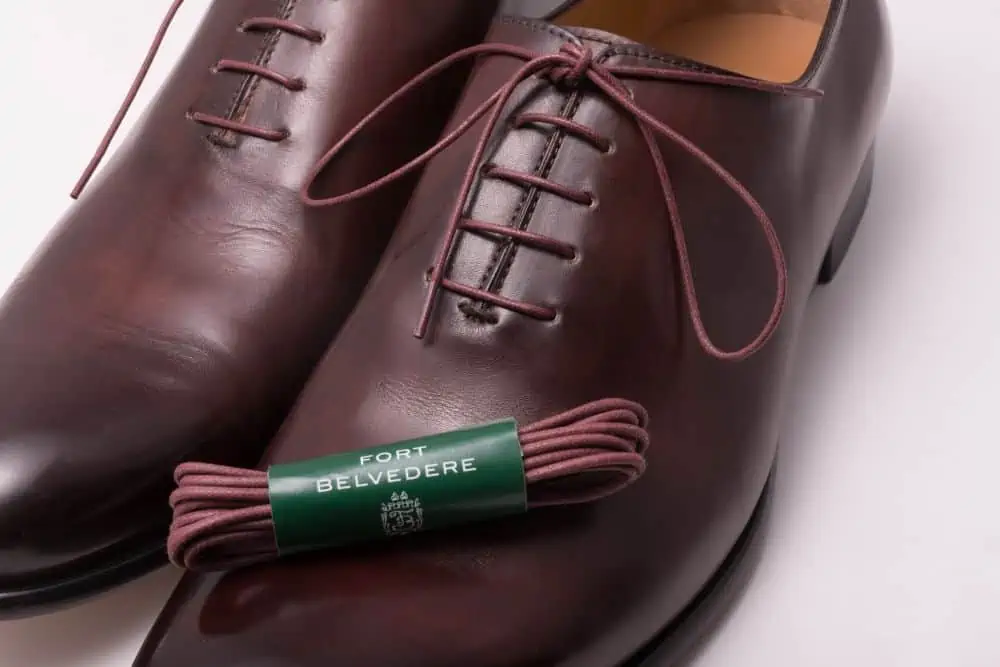
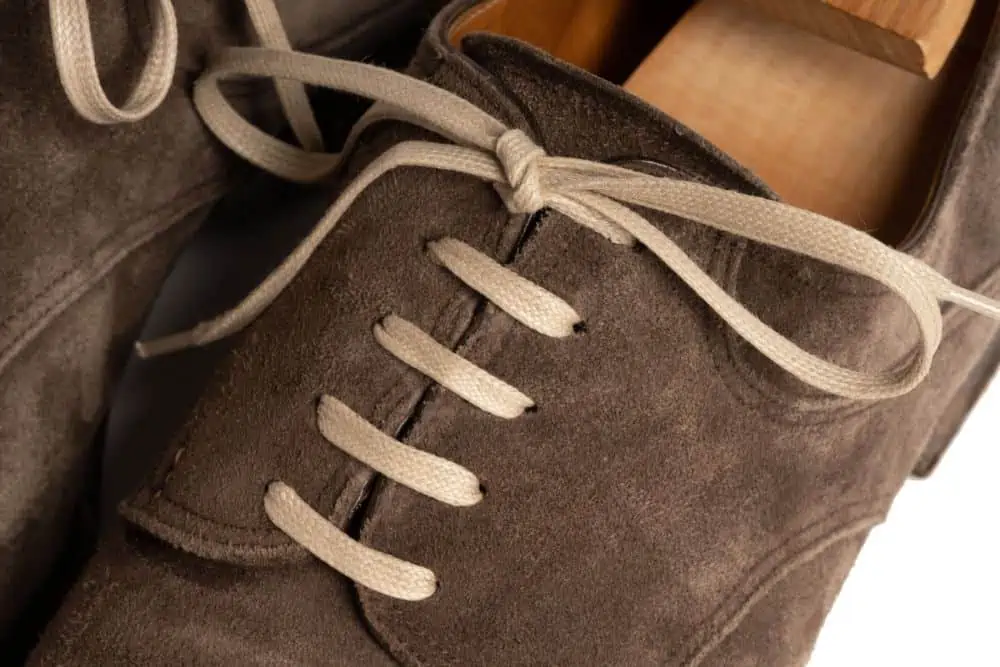
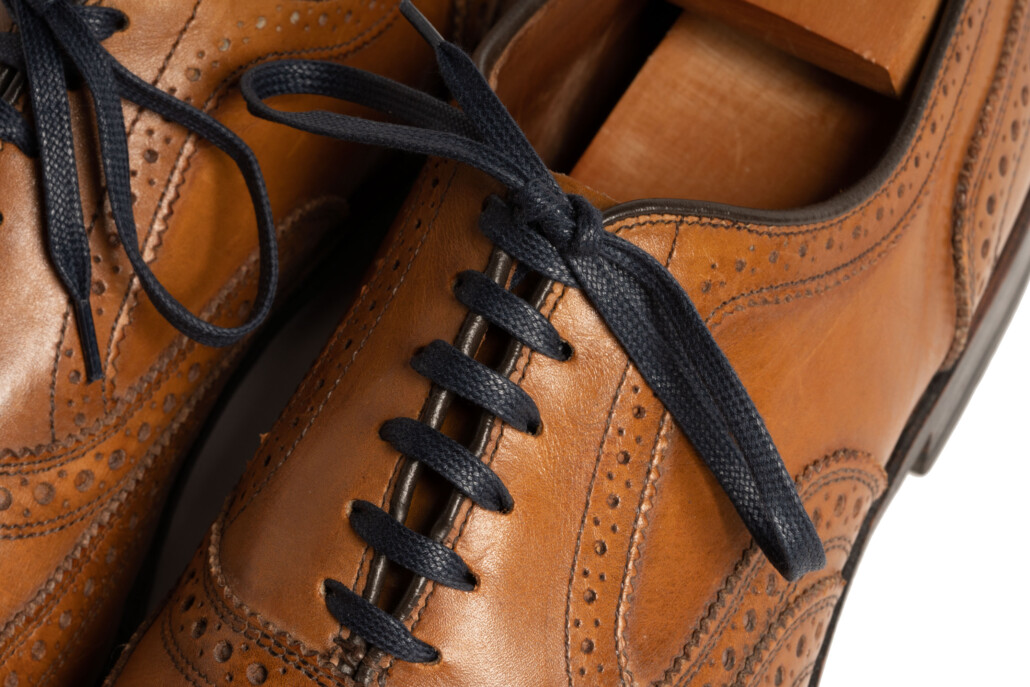
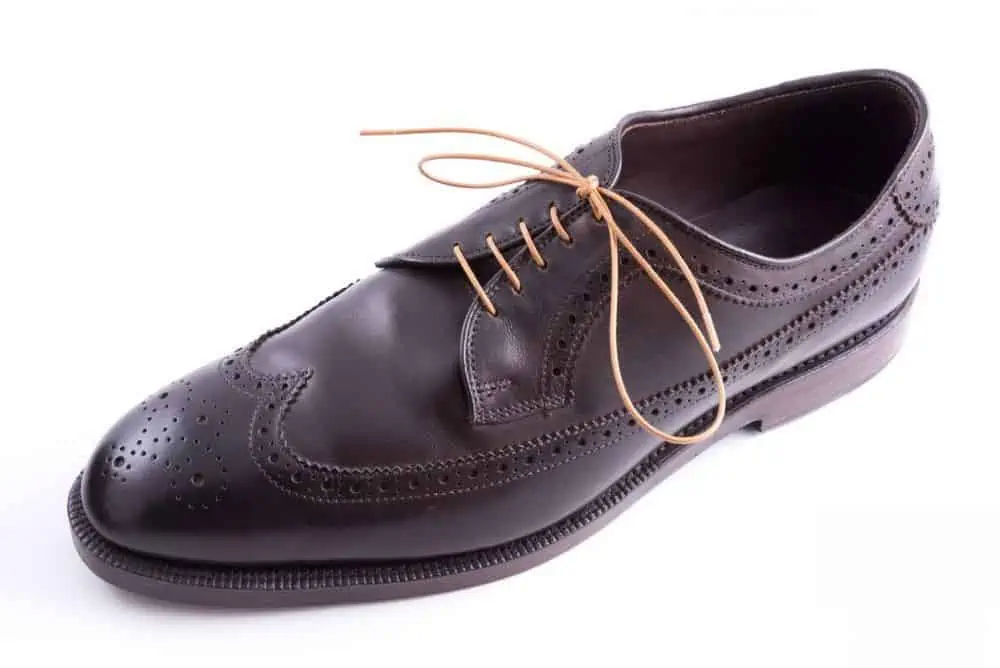
Add Shoelaces to Your Closet
Brown Leather Textures
You will notice that brown box calf leather and suede shoes have been becoming more popular in recent years. Buffalo, reindeer skin, and alligator have been classic, yet expensive, brown shoe leathers as well.
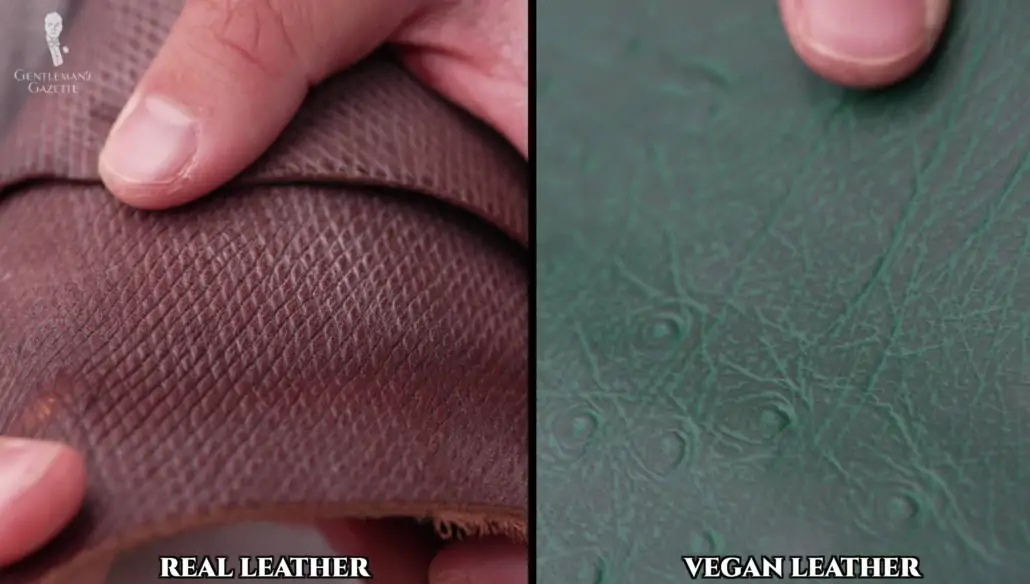
Generally, you should keep in mind that shoes with more texture are less formal. Sometimes you may even see ostrich, pigskin, fish skin, or elephant hide for shoes. Most of the time, the last is not a classic shape and the entire shoe just screams for attention–as such, we would instead recommend wearing more traditional leather shoes with formal outfits, and with casual outfits, choices like brogues, brown suede shoes, brown loafers, or ankle boots.
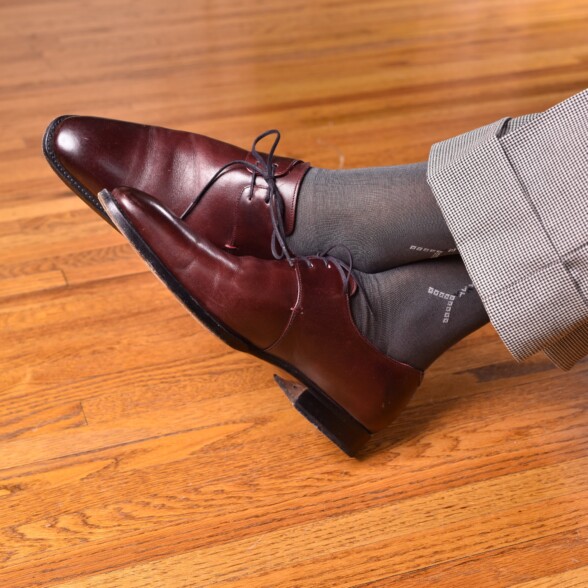
Perfect Patina
Unlike black leather shoes, brown shoes will develop a patina over time, which can be further enhanced by leather dyes and special polishing techniques. As an example, take a look at this beautiful patina.
Brown Shoes & Boots: Final Thoughts
Brown shoes are not a substitute for black shoes, and every man should own at least one pair of black plain Oxfords. But even in a white-collar environment, there is a reason to invest in brown footwear as it is more versatile, it develops a fantastic patina over time, and it is the better color for casual outfits. If you don’t work in an office environment and rarely attend formal evening events, a single pair of black shoes may be enough for you, but you can never have enough brown shoes!
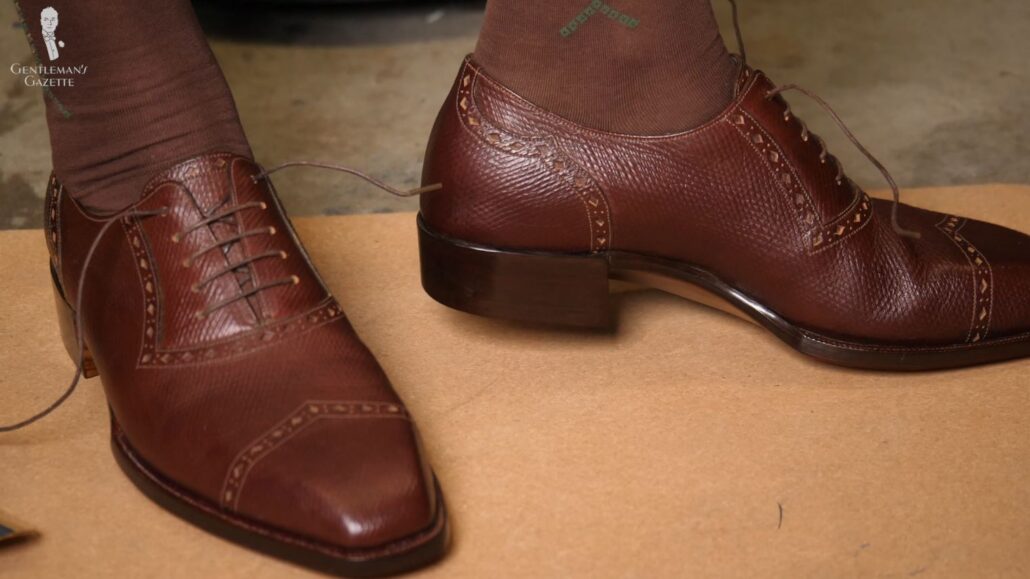
If you like formal evening wear, invest in a pair of black patent leather Oxfords (in Austria Derby’s) or opera pumps – it is historically the correct choice for evening wear, even though some prefer polished calf skin for evening shoes.
In the broad strokes, brown footwear–everything from loafers to lace-up boots, wing-tips to cowboy boots–sports an amazing versatility, and wearing brown shoes or boots with items as varied as button-down shirts and leather jackets will serve you well. All told, there’s a lot that brown shoes and boots can do for you.
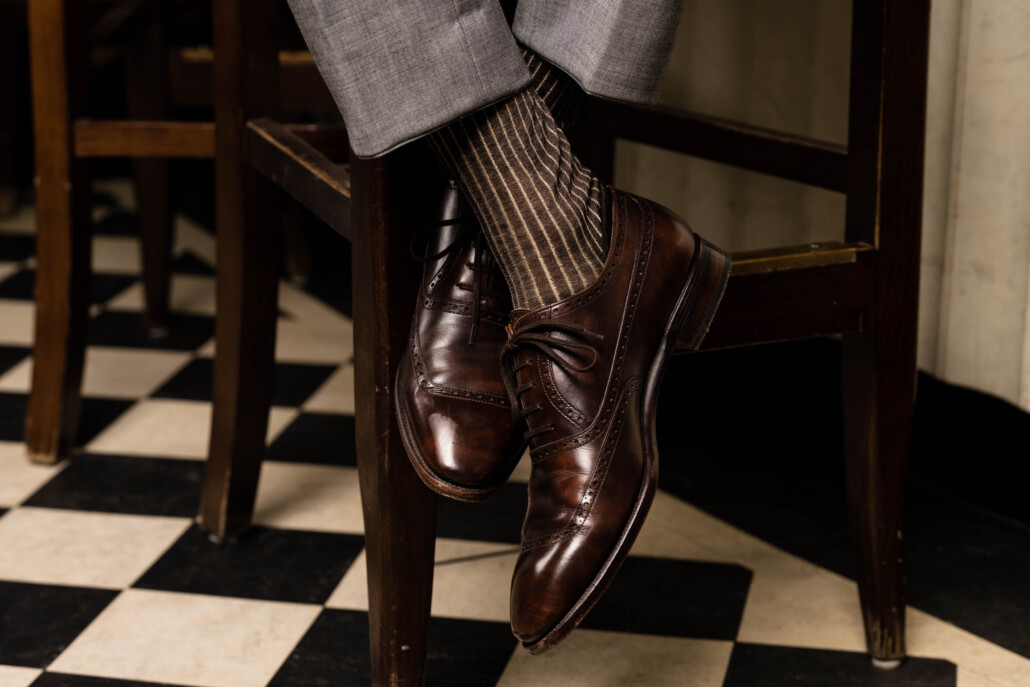
Our Original Brown Shoes Video
We first produced a video guide on brown shoes back in 2015. If you’re interested in seeing how much we’ve grown in the intervening years, you can find that video below!
How often do you wear brown shoes, and what are your favorite ways to wear them? Let us know in the comments!
Sven,
Thanks for the clinic. I thought I knew the basic rules about brown vs. black shoes, but I’ve definitely been making some mistakes.
Question – if you could only buy three pairs of dress shoes, and one is your plain black oxfords, what would the other two be? Perhaps a dark brown cap toe and lighter brown wingtip?
Awesome post…keep it up!
-Brock
Brock, I could write another post about that… The short answer is, a mid brown brogue derby shoe, and a loafer of some kind in a oxblood brown. That way you can almost wear any outfit. Though your shoes will last much longer if you have more shoes available…
What you refer to as ‘spectator’ shoes, I have always known as ‘co-respondent’ shoes. What is the difference, and how did they come by these names?
co-respondent is the British description for it. It’s the same thing. A lot of spectators wore them in during the heyday of classic men’s clothing and in Britain it was associated with flamboyant chaps that were often involved in divorce cases, a pun the legal term of a third party involved in an adulterous affair.
Thank you, Sven, for confirming what I suspected. In other words, co-respondent shoes could be thought of as being a little bit…’caddish’..?
“Black is for no brainers” has been my motto when it comes to shoes, let your style rule don’t be ruled by old fashion styles.
I have one pair of black shoes and they are patent leather to wear with my tuxedo.
I’ve preferred shell cordovan for years and started incorporating various shades of brown in the last 10 years. It’s been part of my subtle anti-establishment independent movement ever since I graduated from college.
Cordovan shoes and boots are a great addition to one’s shoe collection since their patina is different.
Dear Mr. Schneider,
thanks a lot for this very enriching guide. Here’s another reason why this fine gazette stands out in it’s kind.
Greetings across the Atlantic
@ Brent Smith
As far as I know the term “spectator shoes” is rather spread in the US, whereas British would prefer the term “correspondent”.
Thanks Gernot.
My personal favorite: snuff colored suede shoes, any style, with dark navy pants. A Fall/Winter look, substituted with British Tan calf with light grey in Spring/Summer.
I believe the correct expression was ” Gentlemen do not wear brown shoes in LONDON “
To Alkan Kizildel,
You have the meaning right, but one should always use the word ‘town’ rather than the name London; the reason being that in England, London is the only ‘town’ that matters.
The phrase likely originated in England, where town was London. However it was exported to other countries such as the U.S….
I live in New York City and you could write an entire article on horrible shoe choices made by men wearing suits here.I just did an exhaustive search for the book you mentioned by Sydney D. Barney with no luck. Great article, as usual, and I’m sure I’ll reference it in the future.
The ‘never brown in town’ and ‘black only after 6pm’ are over-generalizations of English social dress codes (adopted to a great degree in Scotland and Ireland, thanks to the aristocracy and industrial plutocracy in the 19th century) which developed through the irrationality of fashion.
English influence on the British Empire, and on the wider world in general, has seen essentially English dress codes being adopted, but misunderstood and misinterpreted, in places where such conventions have no historical base and therefore no real importance or significance.
Particularly in North America, where the population owes more to the non-Anglo-Saxon world that to its English colonial origins, the application of English dress codes will always be confused and resented (if only for reasons of political history) and need not be followed too closely.
However, within the British Isles, dress codes are still followed for good reason, and those that flout them will be regarded as undesirable because they either do not care for polite manners of convention, are being deliberately disrespectful, or are a cad of the first water.
Put simply black is for formality and business wear; brown is for leisure and labouring. A gentleman (in the English sense) will only wear brown footwear in the country where his leisure is spent in country sports (hunting, shoot, fishing, racing) and his clothing will be made of a socially acceptable cloth, such as tweed.
In the city (for commerce, trade, political, legal, Court or social business) the gentleman will always wear black footwear – essentially shoes, as boots are still regarded as equestrian (and therefore county activity) wear. Think of the origins of jodhpur boots, Chelsea boots, etc, and you will get the idea.
It is a misconception to think oneself hip, happening, trendy or daringly individual to any degree to wear, say, two-tone brown brogues with a conventional dark business suit – but it is readily seen in London and other British commercial cities. What is done in Milan, Berlin, Paris or New York is immaterial!
The only time brown is correct in town is on Friday, for the tradition was that gentlemen were only in the city on business and they would be returning to their country homes at the weekend. He my also wear brown at weekends in the city if he is at his leisure – in a park, perhaps, as this is taken as being in lieu of being in the country. The Duke of Windsor, when Prince of Wales, was criticized publicly for being seen walking (!) wearing a blue suit with brown shoes – perfectly acceptable because the man was at his leisure.
No matter how smart, brightly polished or exquisitely made, brown shoes are always muddy – symbolically. To wear brown after 6pm signifies you have not bathed before coming in to dinner, and are literally soiled from your day’s activities. The brown-after-6pm wearer is also making a public proclamation that he has no care for his host, the company and surroundings, and would rather be with the beast in the byre.
All that said, in an age when getting dressed-up means putting on clean jeans and designer t-shirt, does any of it matter. Of course it does – how could it be otherwise? If you want to follow English gentlemanly conventions, follow them all. If your preference is for other traditions, leave the English to one side (as, say, the Scots do when in Highland dress) and keep to those you favour – that way your dress will look ‘right’ and will still be gentlemanly.
To Mr Alexander Cave,
Well said. I agree with everything you say, and you say it with eloquence.
Thank you once again for an insightful comment!
Mr. Cave opines, “Particularly in North America, where the population owes more to the non-Anglo-Saxon world that to its English colonial origins […]”
While many Americans’ ancestors came from outside of the British Isles, culturally, we have much more in common with our British cousins than we do with anyone else. This is a large part of why American dress codes (such as they are) are much more akin to English ones than to European ones.
Of course, we have our own ideas of how to do things—we’re funny that way—but downplaying the British, specifically English, origins of our ways risks missing something important.
Greetings Mr. Schneider,
once again I enjoyed reading another well informative article here at GG it is enthusiastically encouraging to learn of the wide range and possibilities of incorporating brown shoes into our wardrobe.
Just one question, I recently purchase a navy wide chalk stripe (2) piece suit and was pondering the idea of pairing it with a medium to dark brown suede brogue wingtip shoes any comment on that…or should I avoid it all together?
Best Regards,
P J Weatherby
It’ll work rather well, especially when paired with knit tie in red beige or a madder or wool challis tie.
Thanks for mentioning the Derby in the conclusion! I am afraid there are actually quite a few things slighty different in Austria.
Best Regards,
René
Can you elaborate on the differences?
Well, concerning shoes I’d say it would be the plain Derby or the Derby decorated as semi-brogue or full brogue and quite a range of boots. Bespoke suits in Viennese Style (see C.M.Frank) and some traditional “continental” coats (not just Loden fabrics).
– René
I know that style enthusiasts love brown shoes.
But I think for beginners with moderate budget, the black shoes are the best option.
Why? Because owning brown shoes simply blows up your wardrobe and your expenses.
-> Think about suitable belts.
-> Think about document bags and suit cases, notebook bags.
-> Think about leather gloves.
-> Think about the straps of the watches.
-> Even the ribbons of your fedora or panama hats.
-> Not to mention a set of different waxes in order to achieve a good patina of the brown shoes.
Owning of even a single pair of brown shoes forces you to buy a number of other pieces that cost a significant amount of money. A set of a good belt, a leather document/notebook case, good gloves and a watch strap would cost easily over 1k.
That is why I prefer to own only black shoes for now and to go for the premium quality instead of buying additional sets of bags, leather straps and belts that I do not necessary need.
Of course as soon as a man has collected a good set of suits, shirts, ties, and black shoes, one could and should go for brown shoes.
But this moment comes only after you have spent a good 5 digit amount of money on the basics(for example if you own a suit, you would also need a coat for the winter, and a trench-coat for the autumn).
Most men do not seem to own enough of the basics in order to have the excess money to go for brown shoes, brown belts, bags ect.
I personally(24 year old) have only 2 suits – both navy (1 MTM and 1 bespoke), 2 bespoke odd jackets, 1 MTM overcoat, 1 bespoke trench-coat and around 15 ties.
For me it makes absolutely no sense to spend money of brown bags and belts in order to buy myself brown shoes. I prefer to use my budget in the next 2-3 years for one more bespoke suit and several ties.
And maybe in 10 years I will come to the point where brown shoes will be an option. :-)
To sum it up:
-> Less is sometimes more. Go for the quality, not for the quantity.
-> If you already own a good wardrobe and you can afford to spend money for brown accessories, go for brown shoes. If you are at the beginning, use your money wisely. And go for black shoes.
Dear Hristo,
I like your approach of buying just a few things but instead go for quality. Personally, I went that route as well, although I also opted for vintage goods as a student and consequently built my wardrobe with a bigger picture in mind – one day, I wanted a complete wardrobe.
Now, if one has a limited budget, I agree with your less is more approach. However, as a student I think it would be no problem to have one have of black shoes with a black belt and one pair of browns shoes with a brown belt. Ideally you have at least three pairs of shoes but you have to start somewhere. Now, if you never wear suits, I even would go that far to suggest just one pair of brown shoes with a brown belt to start because it works much better with a casual wardrobe.
It is always important to look at your needs and your environment. If you are going to be an intern at a law firm, go for black shoes. If you work in Media or Advertising, brown is probably the better choice, if you can only buy one pair of shoes.
At the end of the day, it’s up to each individual what to wear, but I don’t agree with you that every person on a low budget should just go for black shoes, because brown shoes may work much better for them. And instead of a black bag, you can get a brown one, or a red or green one – again, depending on your position, surroundings and your taste.
Dear Sven,
of course I agree with you.
There are situations where brown shoes could be the beginner choice – depending on the needs. That is why a good tailor would always first ask you where are you going to wear your suit.
For my needs black was the choice – for example I like classical music and often attend concerts. I also often attend events in the evening. And in the work environment I sometimes want to look more conservative.
As for the casual situations – wearing brown shoes with jeans might look better than wearing black shoes with jeans. But wearing black shoes with jeans stills looks OK. And at the same time wearing good black cordovan shoes with jeans for sure looks better than wearing horrible rubber/synthetic/cheap leather sport-shoes of any colour as 99% of the male population(in Germany) does. :-)
There is one more thing I want to add. While having many shoes for sure increases their life, they should not be too many if you are a patina freak. Especially the cordovan leather really first need some wear if you want it to look good.
And also wanted to make clear that of course I have several pairs of shoes and I don’t wear them on consecutive days. But the money save comes from not owning different colours of the accessories like gloves, belts, bags ect.
In modern days the animals do not have as healthy life as 100 years ago. They need to grow and reach fertility and add weight much faster and this impacts negatively the quality of the leather. As a result good leather is rare and costs a lot. I payed over 250 EUR for my cordovan belt. And a pair of good leather gloves cost arond a 100 EUR. And you need several pairs from them – thin leather for more formal occasions and thick leather with thick lining for colder days.
Leather document cases and notebook cases chaise astronomic prices.
All these small things eat up your budget and then at the end most people end up with the opinion that they can’t afford a bespoke suit or a bespoke jacket. In fact this is more a matter of priorities and money management.
Hristo –
Your reasoning is rational, and your principles for black shoes no doubt suits you well, but, by imposing such limits, you are denying yourself a great deal of variety and pleasure in your wardrobe.
The dyes used in shoe-leather colouring tend to mean that black is black, no matter what the finished surface of the shoe. Brown, however, takes in the seemingly limitless range of tones from ‘natural’ to the deepest chocolate colour, with tans, chestnut, cherry, oxblood, etc, all adding to the variety for choice.
Black shoes do not have the same options for taking on age-patina in the same way as brown, and the gentler tones of brown shoes make them more easily adaptable with a wider range of casual clothes. The less-is-more principle only works with clothing if it is practiced with quality-not-quantity – a pair of fine brown shoes may do you decades’ of service.
As for the patina, this is helped if the shoes are stored with wooden shoe-trees inserted, which give the strength and support necessary for a good polishing. Vigorously working polish into creases gets the slow process started, and using the army trick of heating the wax until it goes liquid (a hot-air paint-stripper tool is ideal, but the army used to favour a lighted candle) can produce the desired result quicker. The short-cut technique is to use a darker tone polish (some even advocate using black polish) than the shoes might ordinarily require, but this should be done sparingly and with care.
As for value-for-money and longevity of leather goods, I have items of my grandfather’s that are coming on for a 100 years old, and which show little sign of needing to be retired through ill-health.
Thank you, Alexander,
by the way do you use darker colour of the shoe cream(the layer under the wax) or of the water resistent shoe wax?
Hristo –
Having tried shoe-cream, I never use it and find the cire (leather wax treatment) we have here in France is far more suitable, and is absorbed into the leather in a way that cream cannot match. I use un-coloured for all but the darkest brown leather, as the lack of colouring allows the wax to remain softer and more oily – which aids its absorption. As a result, the shoes retain their original colour, but acquire a pleasing patina quite quickly.
I have always used water-proof dubbin on those boots and shoes that get used in wet conditions – again, the oiliness of the dubbin produces a loved-and-well-cared-for appearance to the leather, even if the dubbin never brushes up to anything more that a sheen.
Having learnt as a young man the army trick of ‘bulling’ to produce a mirror-like shine, all my black shoes for the past three or four decades have had that treatment – the time spent initially achieving the result has paid off well later. But you can over-do it – I have been asked if the heavily-grained regimental officer brogues that go with my day-wear Highland dress are patent! Try Kiwi ‘Parade Gloss’ if you want the next best thing without ‘bulling’.
It is not really a matter of priorities and money management, but values and social consciousness. The times when one could buy a belt for 250€ and walk the streets without a care in the world are over. Something I would consider an achievement.
Besides, no one cares whether you wear the same pair of shoes on consecutive days or not and if they really should do, their priorities are properly amiss.
Yes, caring for your wardrobe is fine and commendable, but do never ever fall for the idea that your wardrobe will ever change you or other peoples’ perception of who you are.
So don’t enumerate every single piece of “expensive” wardrobe and then end by telling people it is all about priorities and money management.
In the end, it will just make you look like a parvenu.
Dear Daniel,
not wearing the same shoes on consecutive days has nothing about looks or being a “parvenu”, but about the care of the leather.
Shoes need to rest for a day in shoe trees in order to dry from the human sweat and to prevent damaging the leather.
Having 2 pairs of shoes, using shoe trees and changing them every day extends the life of the shoes. It really has nothing to do with looks. They could even be 2 absolutely identical pairs of shoes.
It has also nothing to do with “expensive”, but about quality.
The “expensive” belt I mentioned is from a small German producer, I’ve never heard before and most possibly nobody here has heard of. It’s price does not come from stupid advertisement or achieving a cult status, but from the materials used and from the quality of the work involved.
I’ve also had a 30 EUR belt in the past. It broke after one year of use. Compare this with the leather peaces of Alexander that last for several generations.
Buying high quality products in moderate amounts is the most sustainable thing you can do for the society.
Yes, Prince Charles wears 4000 GBP Savile Row suits. But his suits last for decades and are being constantly repaired over time which is much more responsible then buying every year a new cheap suit produced under inhuman conditions in Asia and then trowing it away wasting thus the nature resources and producing pollution.
Hristo,
I appreciate that you believe in “Go for the quality, not for the quantity”, because that is certainly the right mindset, yet you have to understand that that is an approach one has to be able to afford and I am not referring to money alone.
The most profane loss you will suffer is that of spontaneity. Not being able to buy something that appeals to you right here and now, because it doesn’t fit you purchase schedule or black gloves.
As a natural result, you lose your individuality. Yes, you may say, that comes with wearing bespoke or MTM, but at the end of the day, it doesn’t, because you will always settle for a very conservative style with these expensive pieces, because that way they will always be “in fashion”. Yet where are you? Not in the patina of your shoes…
Apart from those superficial issues, you may want to consider that there might be circumstances that will change your priorities and rightfully so. Family for example. Cause in 10 years time, when you want to start buying brown shoes, it is rather likely that one of your babies will have pucked onto your bespoke suit and you have to start saving up for another one before you can buy 500€ brown shoes.
Last but not least, it shouldn’t come down to “I can, therefor I will”. See, when my grandfather retired, he could have chosen to buy himself a new S-class, but instead, he settled for a demonstrator C-class. It offered the quality he wanted in a package that suited the image of commendable restraint a true Gentleman should aspire to.
So please embrace the notion that things don’t have to be the best, but simply good enough. It will allow you to live life in a more varied way and also make yourself more approachable, because people will otherwise find it hard to reach out to you with your aura of acceptance for nothing but the best.
That is exactly why I do not like style forums and style discussion boards.
I just wanted to point out that before buying shoes in various colours one should think about the hidden costs of accessories in the suiting colours. Nothing else.
And somehow the discussion came to how am I going to feed my kids =) =) =)
People, be happy and don’t take the whole style and shopping story so seriously. =)
I start to believe that personal dressing discussions is something that should stay between the tailor shop walls and should remain private.
Excellent article Raphael. Although I tend to experiment even more, but the suggestions are very aptly described.
And I personally find the hues and aging / patination of browns far more engaging and of character than blacks. Perhaps I have only 5 or so black pairs from the 40 odd pairs I enjoy
Wow, is nice that i found this before deciding to buy some shoes, i was going to totally avoid brown shoes (as i always do), but the key is the context in which you use brown shoes. What about shoes from colors like red or white?, are white shoes only used with white suits?,
Thanks, Ruben.
I enjoyed your article, but depending on the situation I’m quite comfortable breaking the rules. For example, I have a great pair of deep cherry wing tips and will sometimes wear them with a black pinstripe suit. Before anyone passes out in horror, let me explain.
The black suit has a very fine off-white stripe. I wear an off-white shirt to set off the pinstripe and add a paisley tie. The tie has a burgundy/dark wine base with dark grey, off-white, and touches of blue, purple, and lavender in the pattern.
Both the suit and shoes have a formal look, but for different reasons. With the suit, it’s the color and fabric. With the shoes, it’s the style. The off-white shirt provides a neutral base for the tie, and the tie is strong enough to balance the shoes. The color of the tie is the most obvious anchor, but the curves and ornate pattern found in the paisley mirror the curves and design patterns in the wingtip.
The above description may sound hideous to some, but it really does work very well. There’s a lot of harmony in the details, and it makes a bold and attractive statement. I think if you’re comfortable being noticed, and have the confidence to wear the clothes and not let them wear you, then it’s fine to go against the grain sometimes.
It’s incredible this sith with different inforations and contents about men’s lifestile! We Brazilian need to share masculine fashion inovations around the world! Congratulations for the site! Até mais!
It’s incredible this site with different inforations and contents about men’s lifestile! We Brazilian need to share masculine fashion inovations around the world! Congratulations for the site! Até mais!
Don’t you ever get bored with just black shoes? I like to see both men and women wearing all colors, whatever matches their pants or slacks, since pants and slacks are the nearest to the pants or boots.
I am looking at buying a pair of light brown boots. They call the color bourbon. What pants do I wear them with and does the belt need to match?
Nice article! I love brown brogues :)
Many thanks for this article, Sven.
May I ask you, what are the references of these exquisite tweed shoes?
Best, jpw
Dear Raphael,
A really wonderful article and the photos of shoes and sox are a treasure. The thing I like about brown shoes is the warmth they can bring to your personality plus it seems people in your company seem to relax more .
I have a selection of brown types which also includes suede and boots too. I don’t go much on patina personally , preferring shoes to be pristine ; that’s just me though .
Cheers
Mark.
Another great primer for the man who would be dandy! Bravo Sven!
Thanks
Can you show us how to clean suede ? It is hard to take good care of.
Thanks!
I will put it on the list.
Sven et al,
Very interesting article. Thank you. Here is my take on this important issue: 1) Never wear, please, white socks with black or brown shoes. And please don´t ever use short socks with a suit. I dislike seeing GQ pics where men appear trending summer looks w/o socks. 2) Brown shoes look nice with gray suits. But, I also would opt for the burgundy red tone when wearing this colored suit. 3) I agree, no black shoes with a khaki suit or a camel one. Here´s my response to your opening question: I proudly have about 10 brown colored shoes, and about three pairs of brown toned boots. It´s essential for any wardrobe to have a plethora. I highly recommend to polish brown shoes with yellow colored shoe polish when you want to clean them and give them a nice finish.And real brown for really brown shoes. Tan ones work best with a red and yellow mixture. I love suede. But I need to learn how to clean them. As with traditional footwear I never use instant sponge ended or tipped shoe polish, but the real stuff.I would like to find Chinola down here in Colombia. I heard they are manufacturing new stuff, among them bikes and shoe polish, even watches in Detroit. And for winter, please know that suede is forbidden! But, if you hand polish them, the leather ones they end up waterproof. I despise how nowadays men´s footwear no longer has really thin “wooden” soles, instead they have some 4X$ ugky looking soles, that are really thick. How can one wear a 3 piece suit, my daily unform, with these ugly looking shoes. And I hate artificial leather. I think plastic, vinyl, acrylics m ake feet sweat and they can´t even breathe, hence Athlete´s foot and many bad odors. I also like having my footwear refurbished or renewed by hand, They do get that nice tone, I forgot the word Sven uses, I gotta learn it, cause it sounds kind of nice. I also enjoy more my handmade footwear instead of those from the big Chinese manufacturers,I invite other readers to consider coming to Bogotá, Colombia and purchasing genuine leather footwear and fashion. You can get good prices, and sui generis hides from farms that grow crocodiles, snakes and other animals. But I am way too conservative to wear reptile/alligator leather shoes. I prefer cattle, bovine and more traditional cow hides. I have also leather jackets , but that´s way off the topic. Thanks again.
uhhhhmmm,Sven you are really moving my attention towards classic fashion of the 21 century gentle-man. i have seen and read all which is really of great help and has made me opt for new ideas about fashion. i for one love fashion and both black en brown shoes make a deal for me but i find it hard to match a black suspender on brown shoes..is it applicable..
Dear Raphael ,
I just got myself a smart pair of flannel trousers in a maroon flannel with a herringbone pattern .
What would be your suggestion as far as shoes go ? I have a nice leather bomber type jacket in a London type tan as well . They look like they could make it together .
Also ; if you have not yet done a feature on mohair could you please try and squeeze that in
Regards
Mark
Sydney Australia .
Hi.
Thanks for this nice review.
I would also be highly interessed in a guide to clean shoes.
Thanks
Franz
Don’t get me started on shoes. I am kinda of a footwear nympho! L :-P L
Her in Sydney Australia there is a current (wrong) trend of men wearing a brown belt and black shoes and vice versa. No way! I never wear any black with brown at all. Mostly I never wear black trousers or suit. I usually wear Blue or Grey. I wear a mixture of Black and Brown shoes depending on the shade of my pants. Your videos are always informative.
I have a fabulous pair of Alden, dark brown suede, mocc toe bluchers that wear well with my navy or grey suits, and go fabulously with denim jeans and sportcoats. I realize that suede may be considered a bit more appropriate for fall or winter wear but I absolutely love the subtle texture interest that the suede finish brings to the footwear, particularly with a heavier fabric and/or cuffed trousers.
I have issue with the interdiction on black oxfords with denim jeans. With a proper pair of 501s & a polo-neck sweater over a washed oxford of some sort, black captoes slot in perfectly—even better with a black necktie. Throw a donegal tweed sportscoat on over & you’re golden. They provide an excellent way to dress up a neither-here-nor-there smart casual outfit into a much more classy ensemble, imho. Though the tie might push it over the edge regardless, I’d never wear a tie with sneakers, & I rarely step outside without a tie.
excellent video on brown shoes.
Guys,
On a general point, please, please, please get rid of the “whoosh” sound effect you use when making cuts in your videos. The effect it has on me (hey, I just made a Preston Pun) is akin to someone jamming chopsticks into my eardrums. It is the auditory equivalent of people using an apostrophe with a plural. Verbal examples of such gross overuse/exposure are currently popular terms such as: “y’all”, “iconic”, “literally”, and “diverse”.
They are almost physically painful. I love your videos and would hate to start muting them.
Thanks
All,
Once again, inspiration strikes after the fact. Just a while ago I posted a comment beseeching you to stop using the “WHOOSH” sound effect in your videos. Right after clicking “Post Comment”, it hit me (kinda like the frisbee that seemed to keep getting larger and larger – hey! another Preston Pun). My mother used to tell me that I should not find fault unless I had a better way. May I suggest you replace the “WHOOSH” sound effect with the Wilhelm Scream? I think it would be perfect.
Toodles
Thank you for another excellent video. It has inspired me to step up my shoe collection.